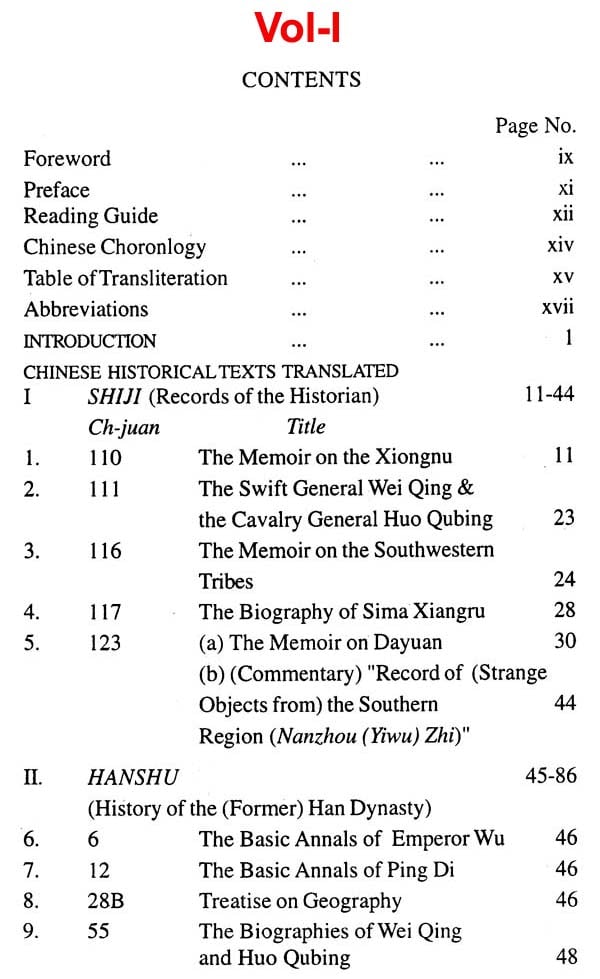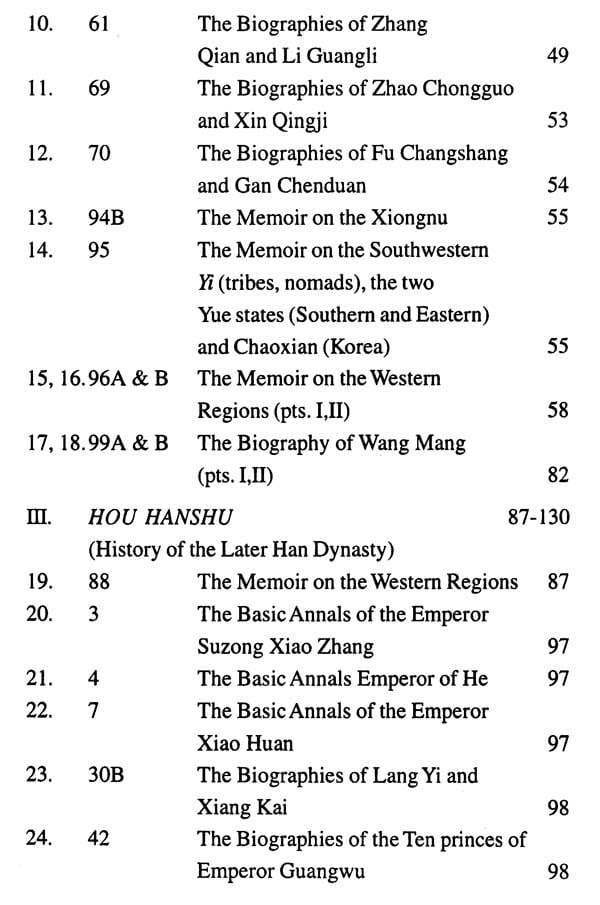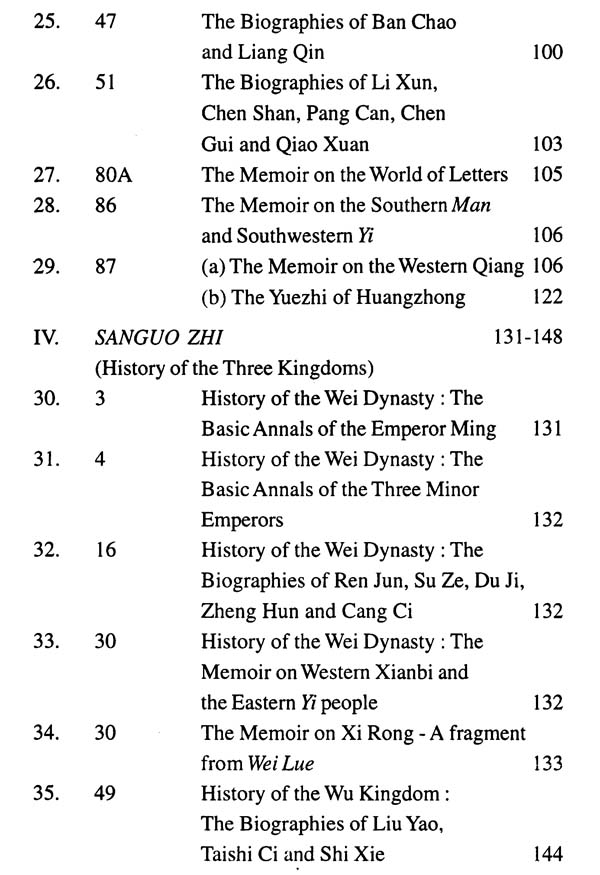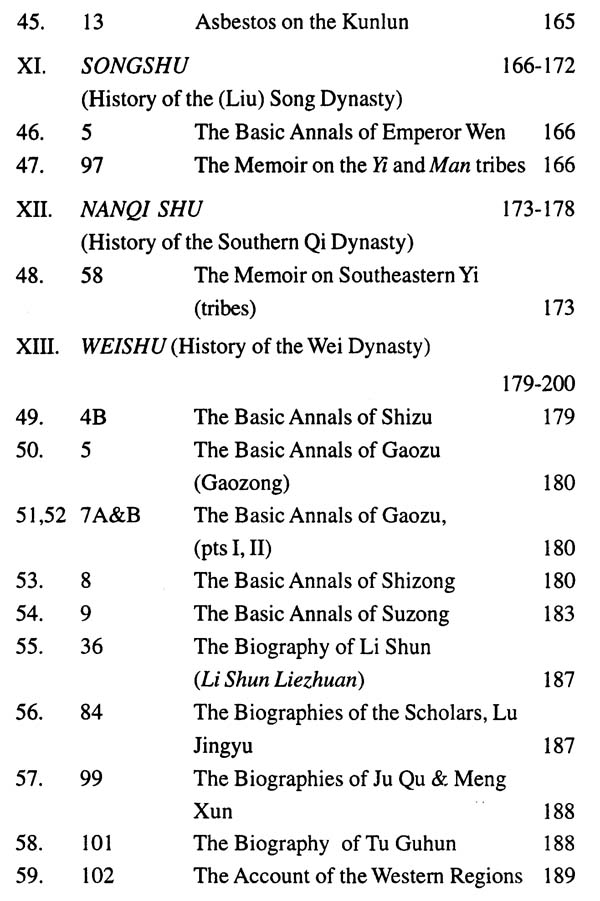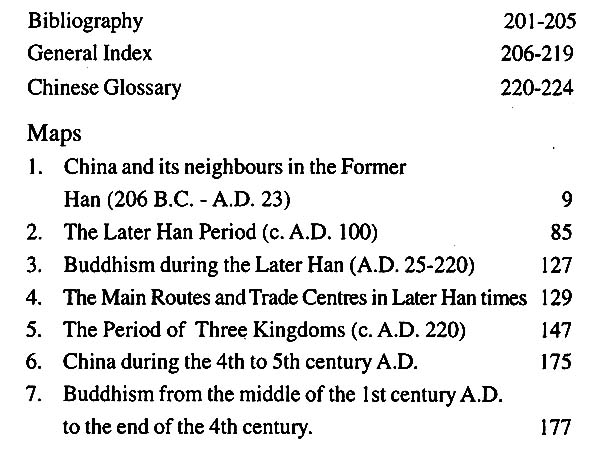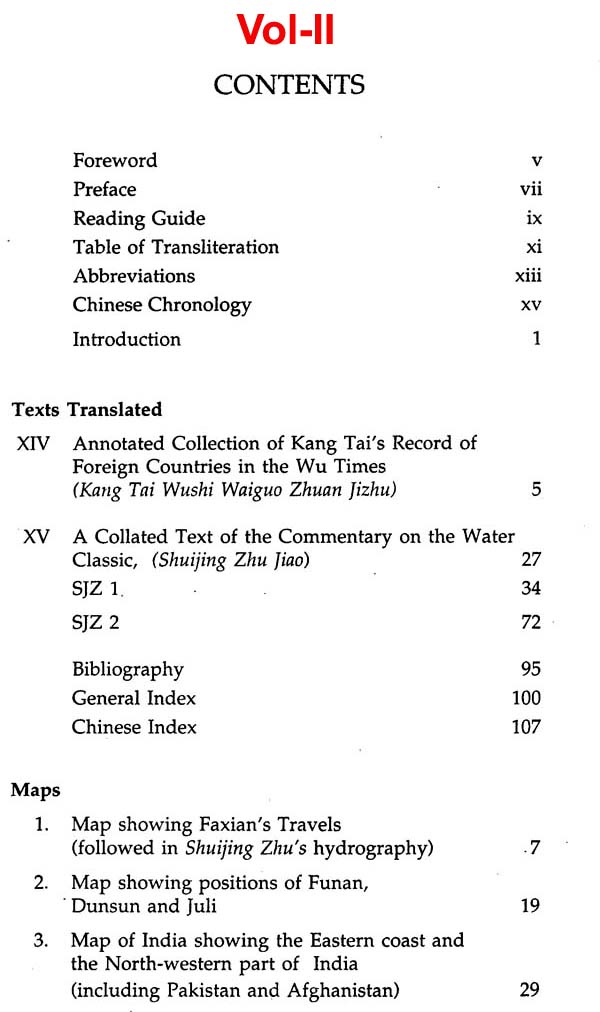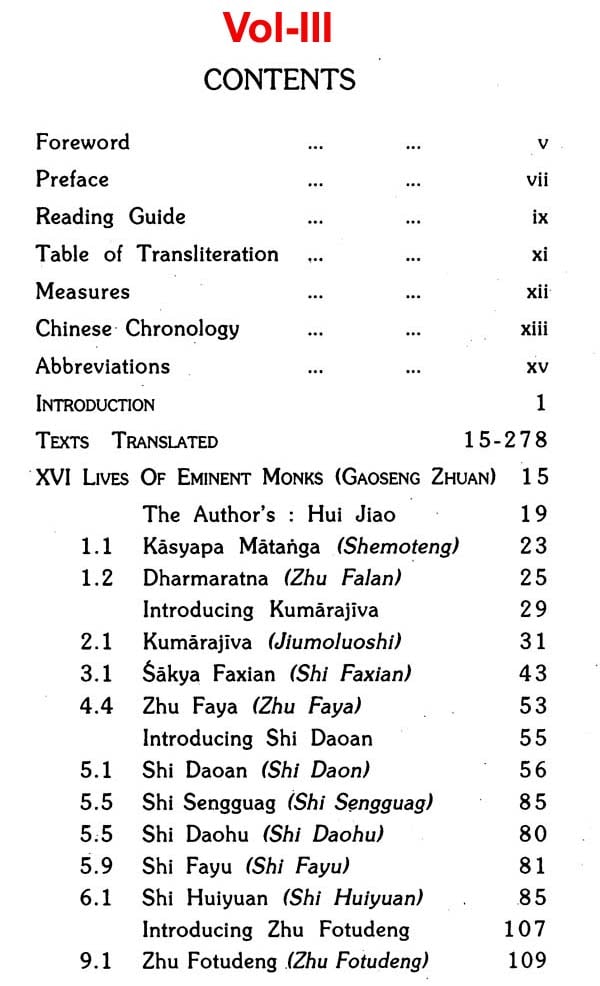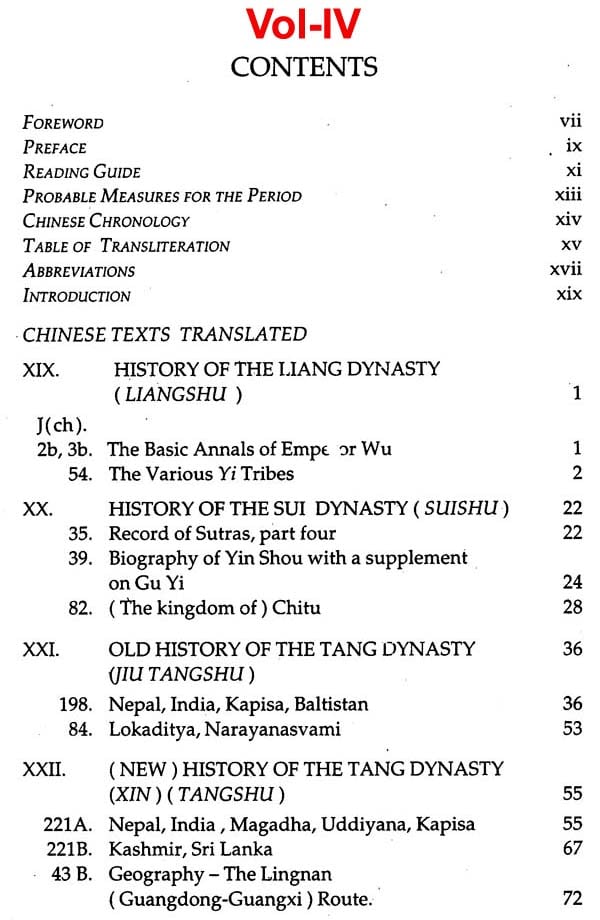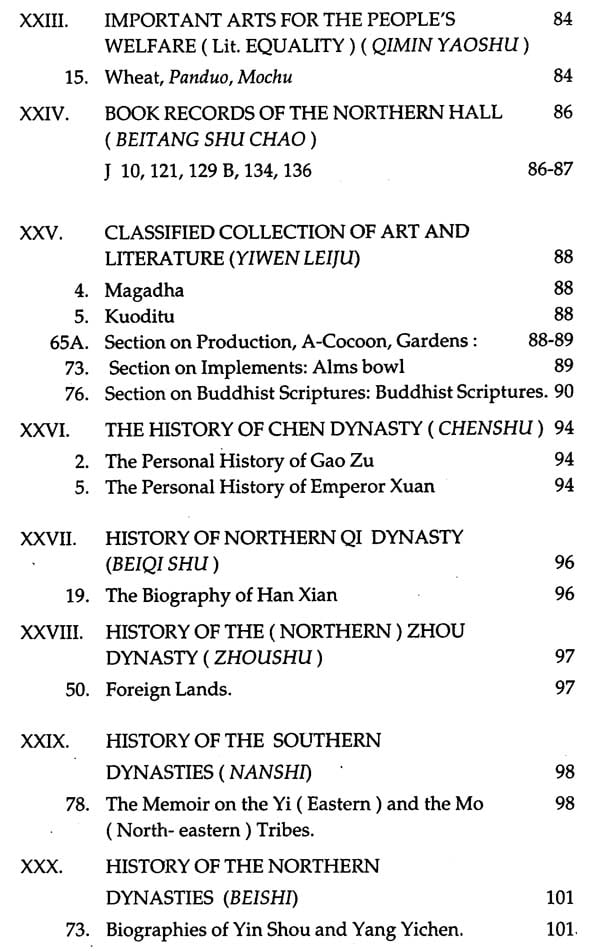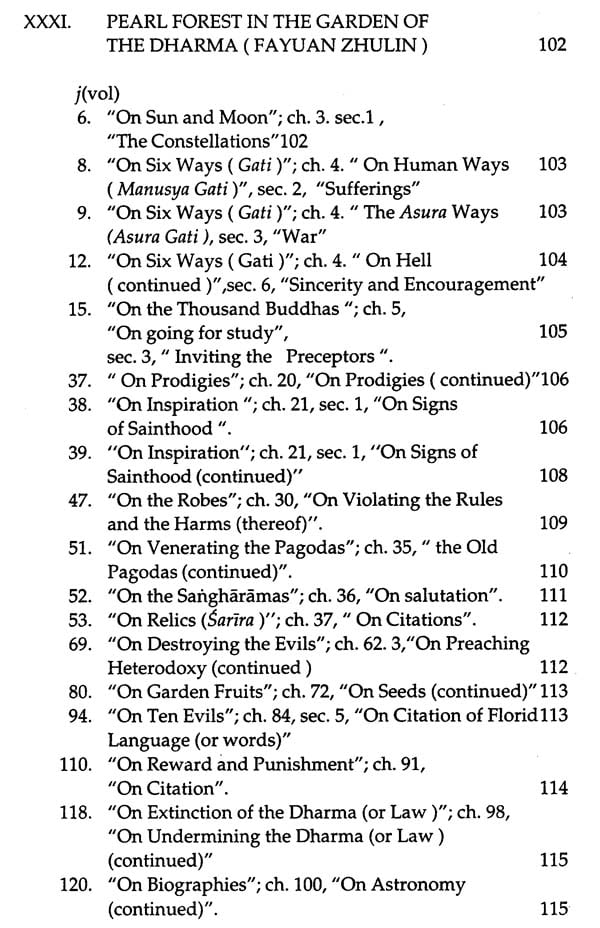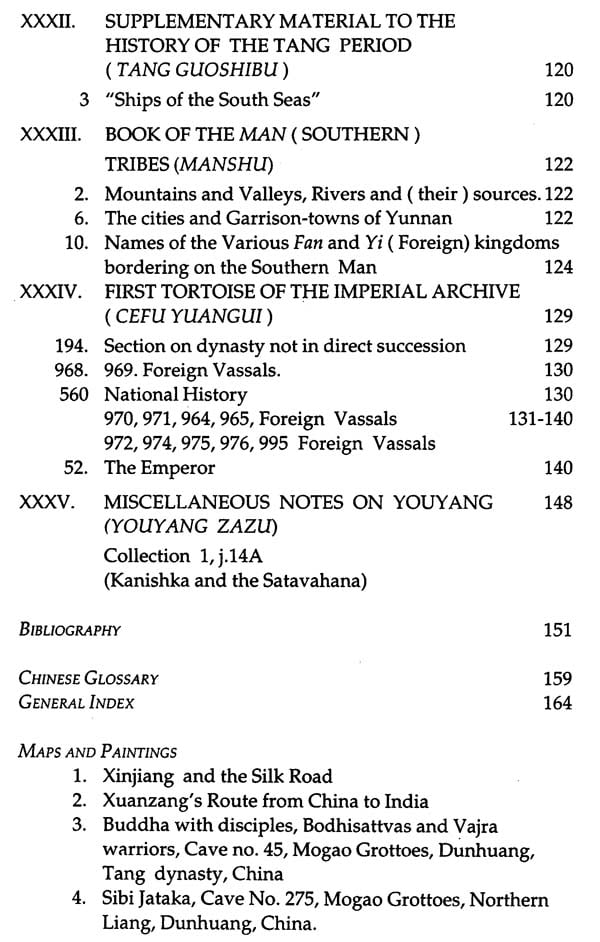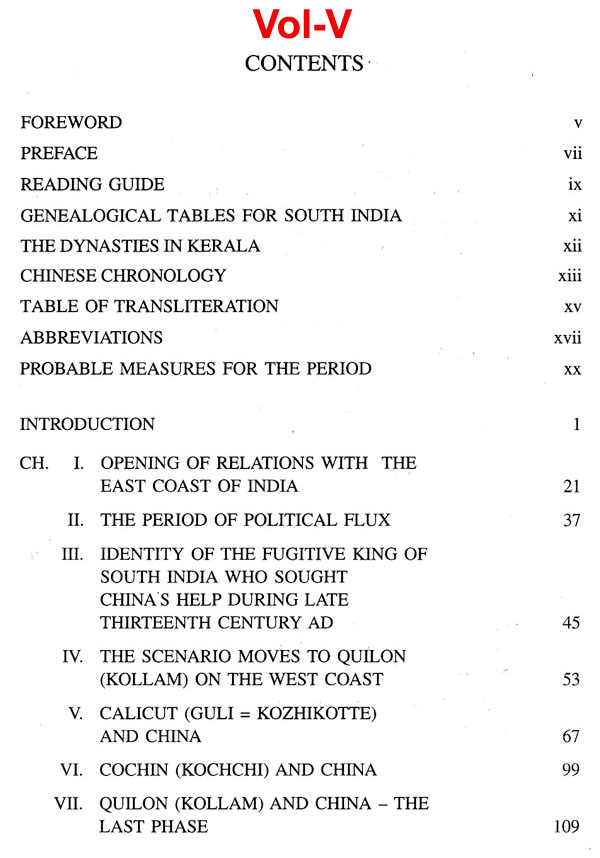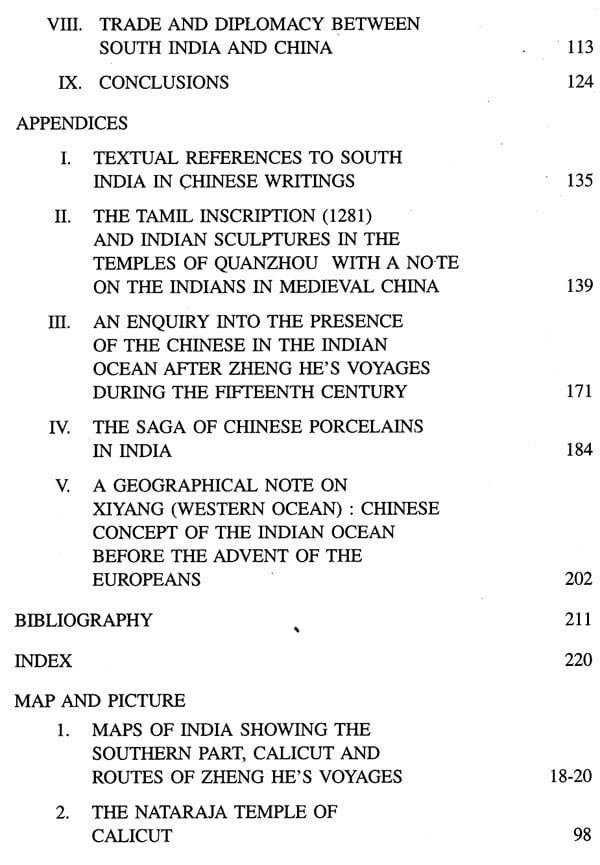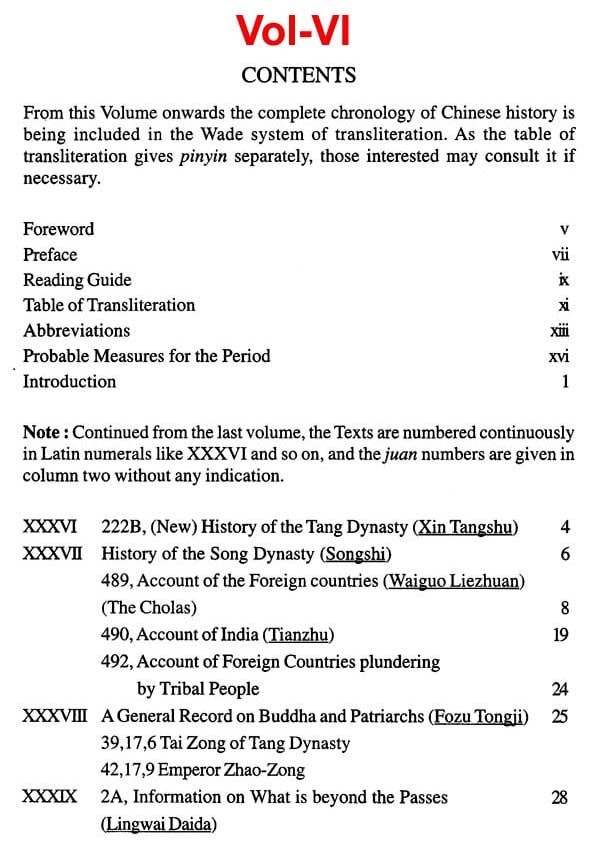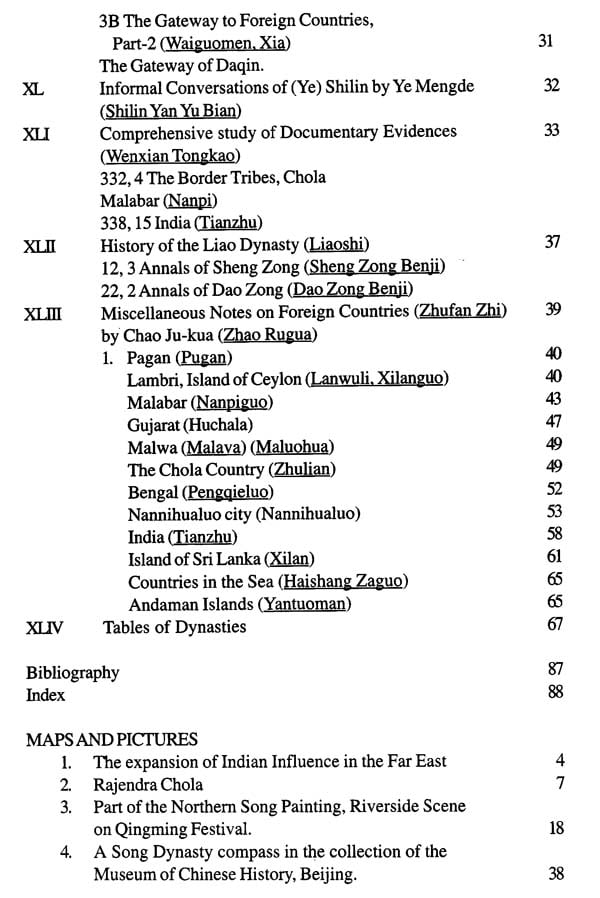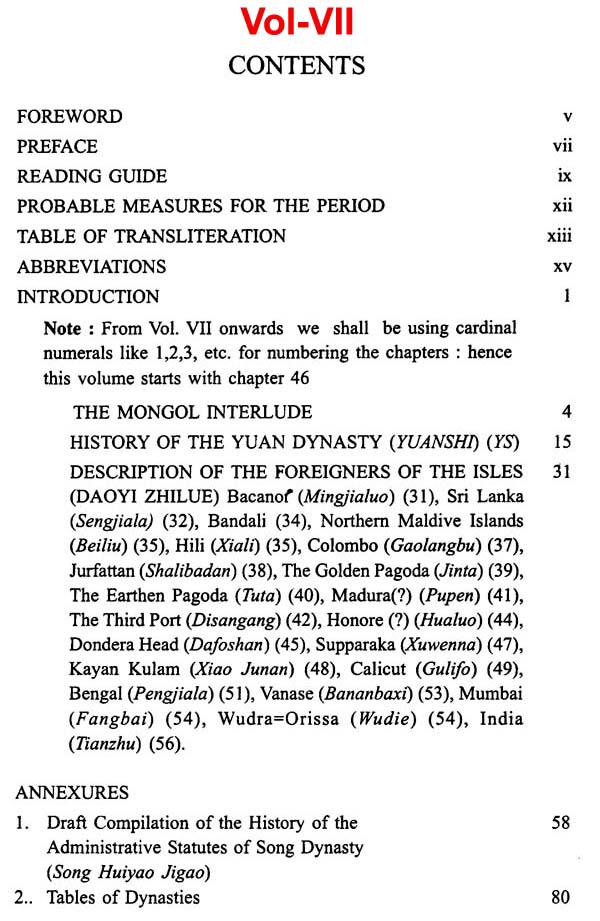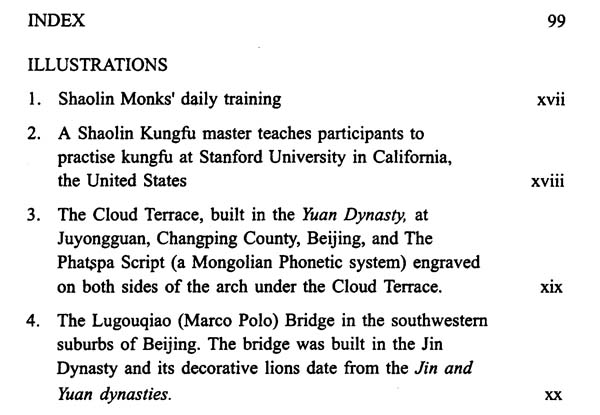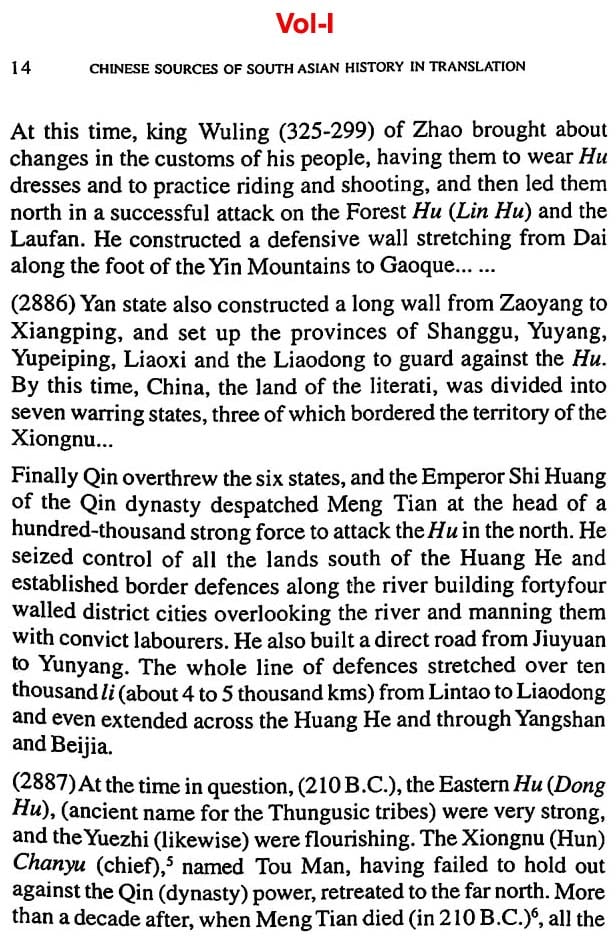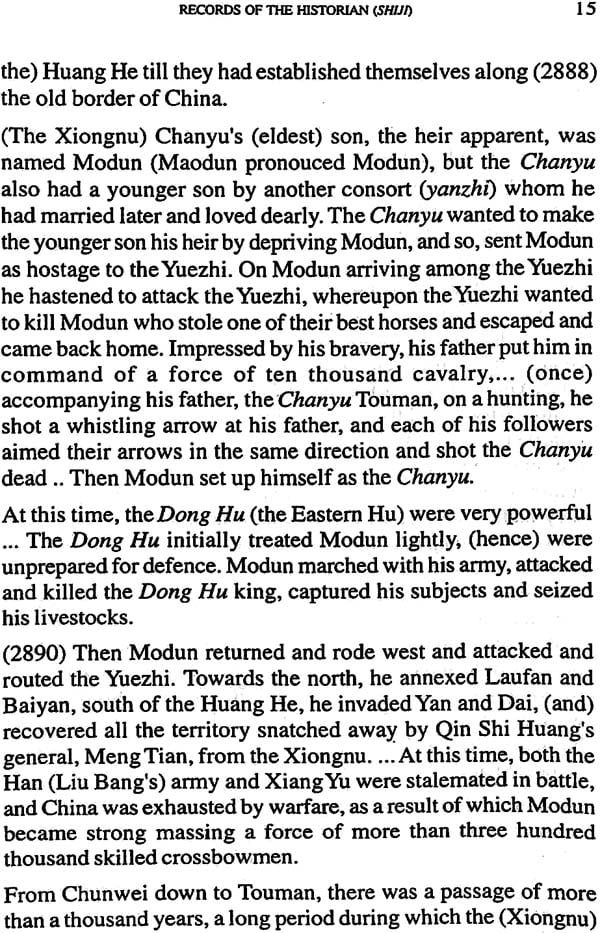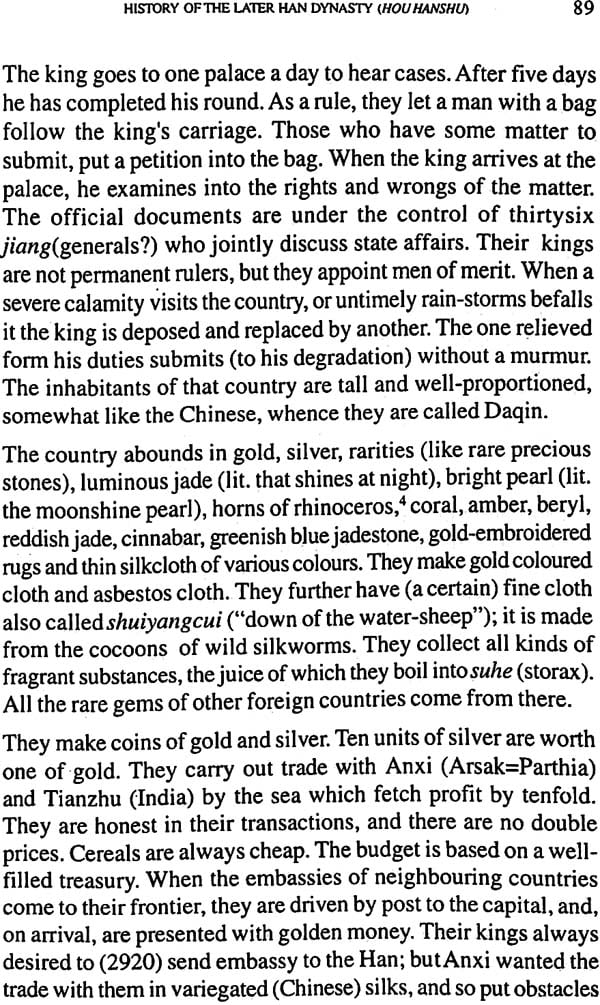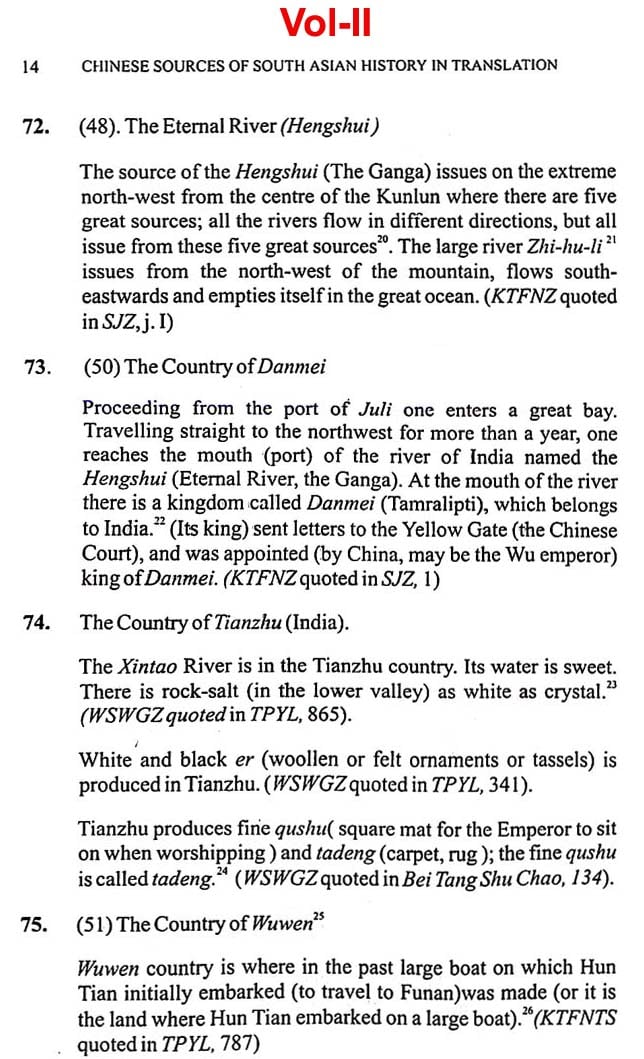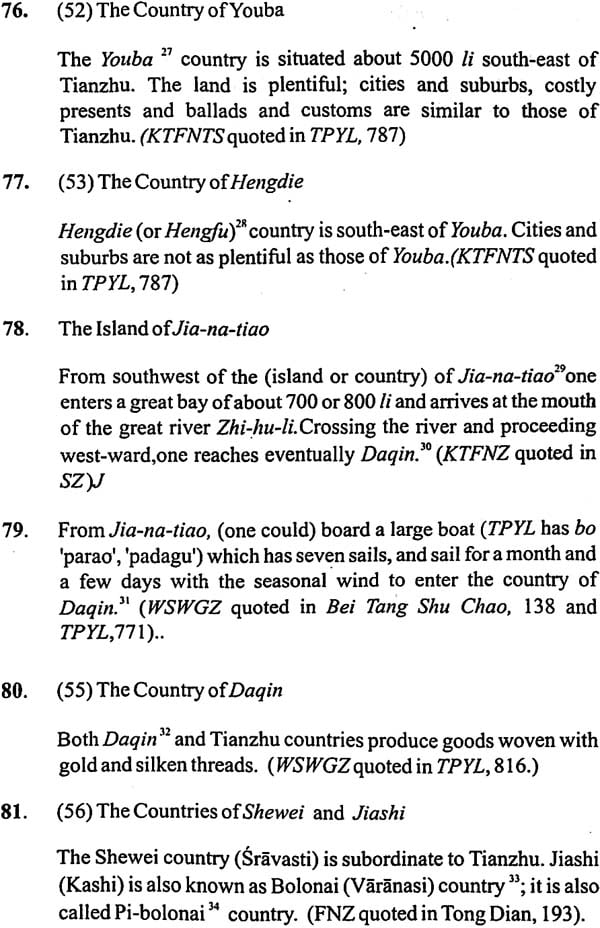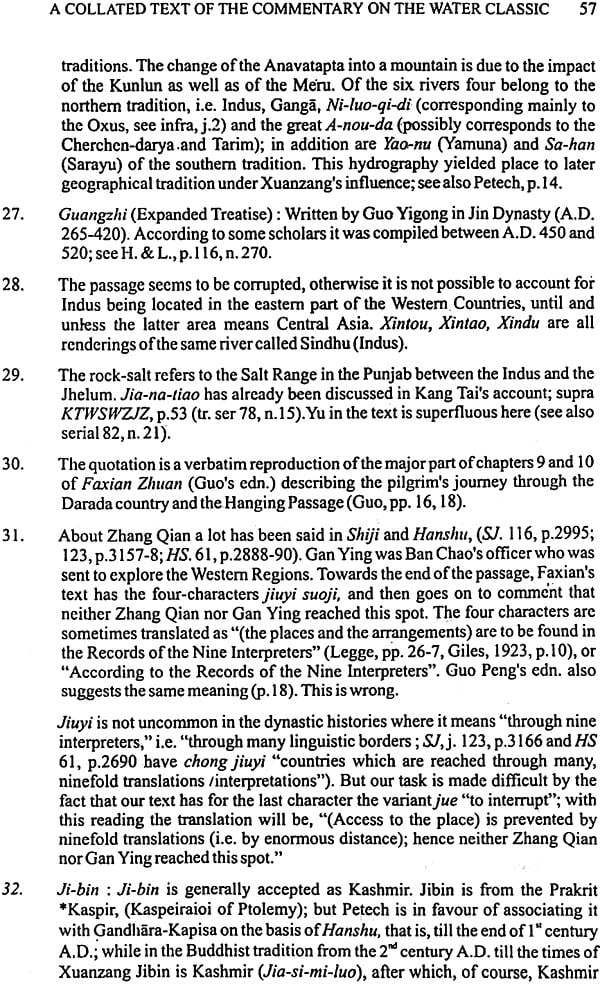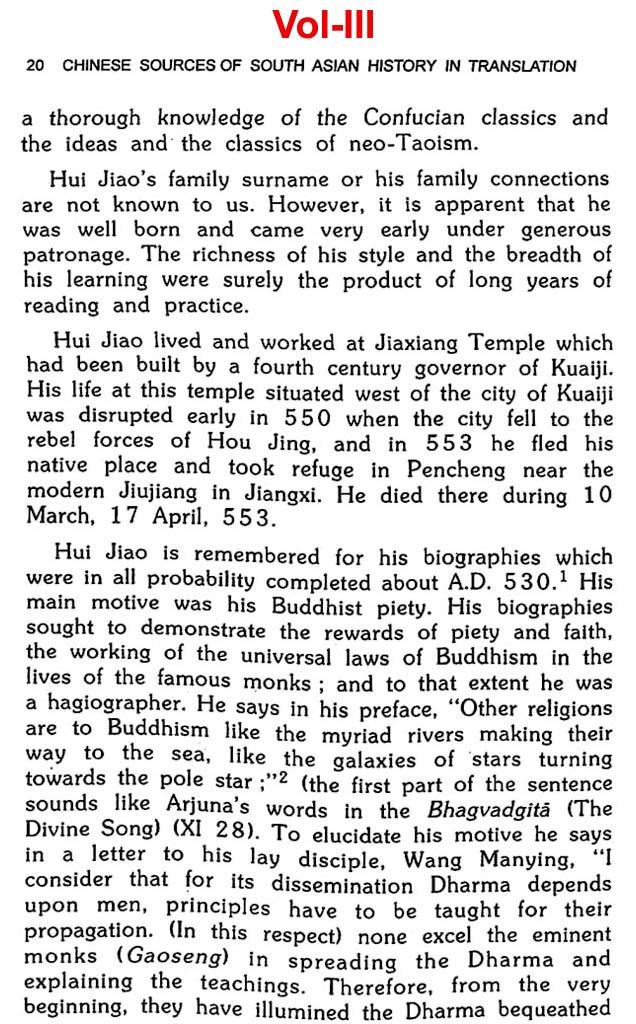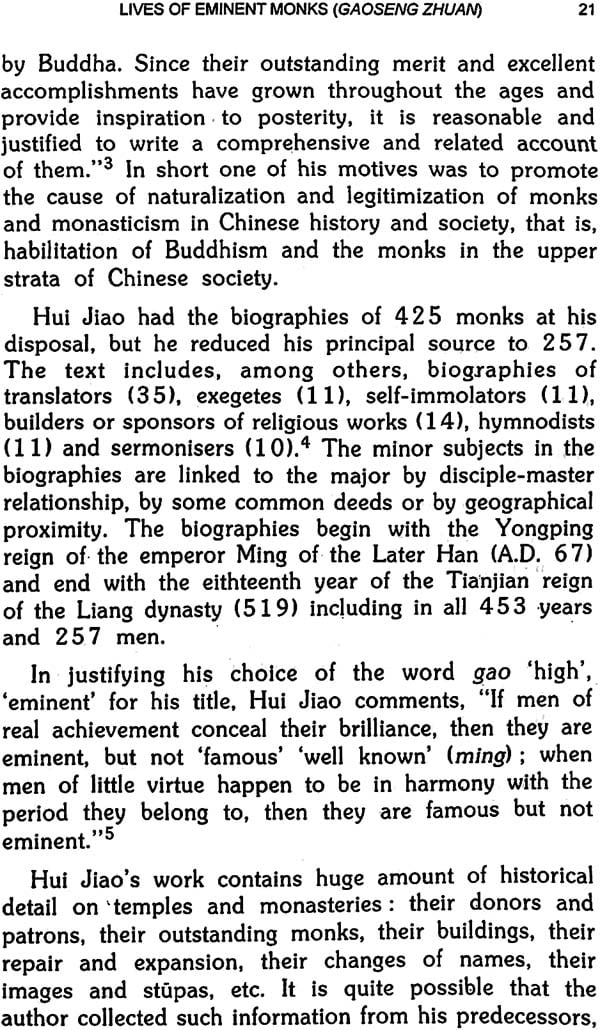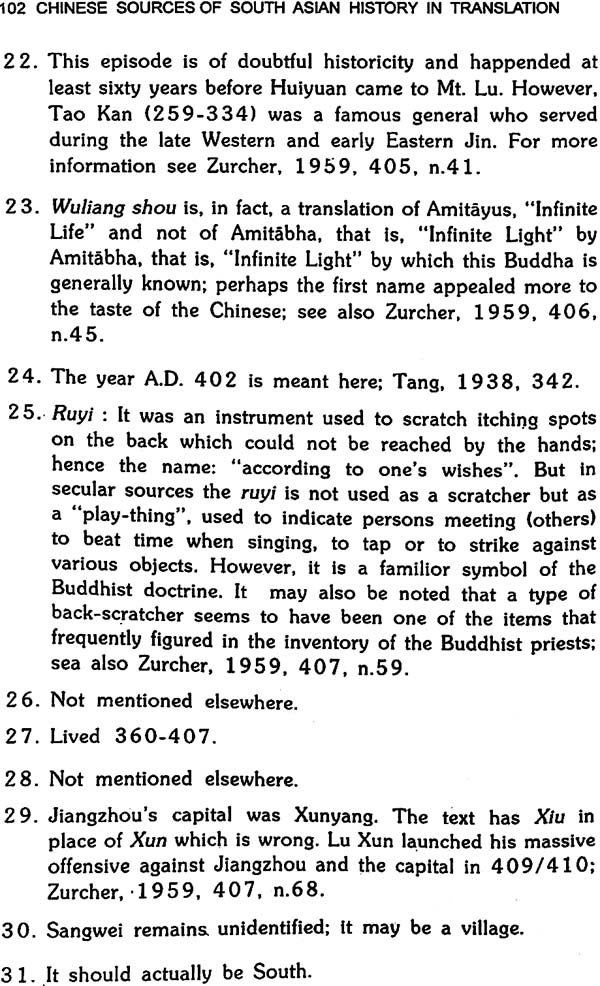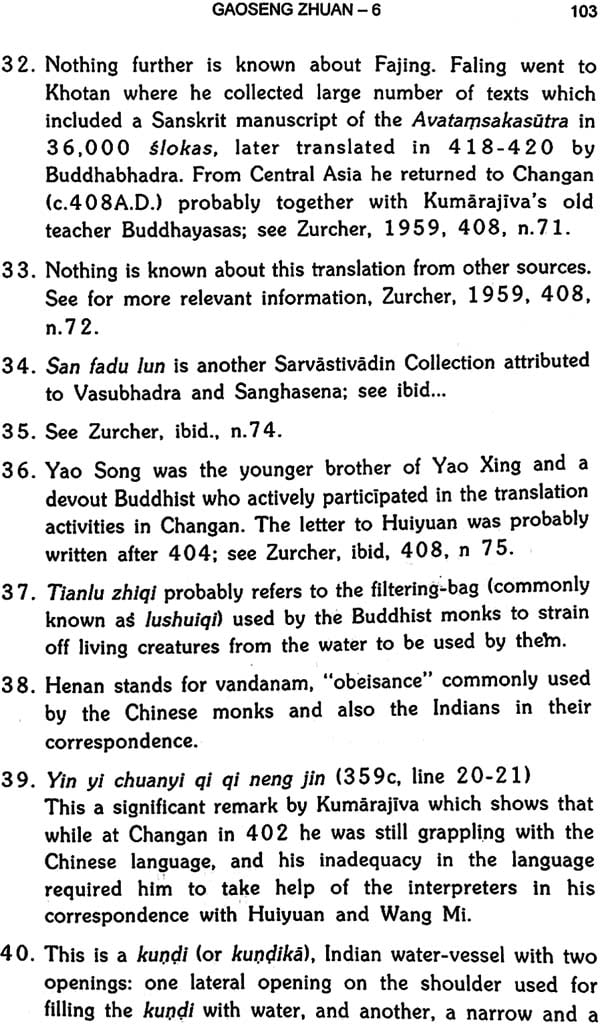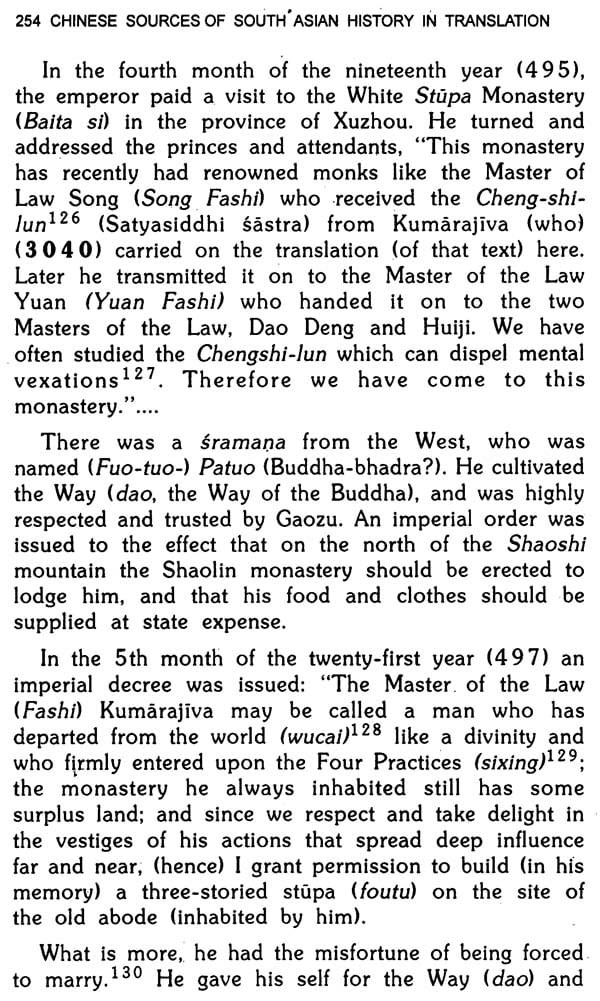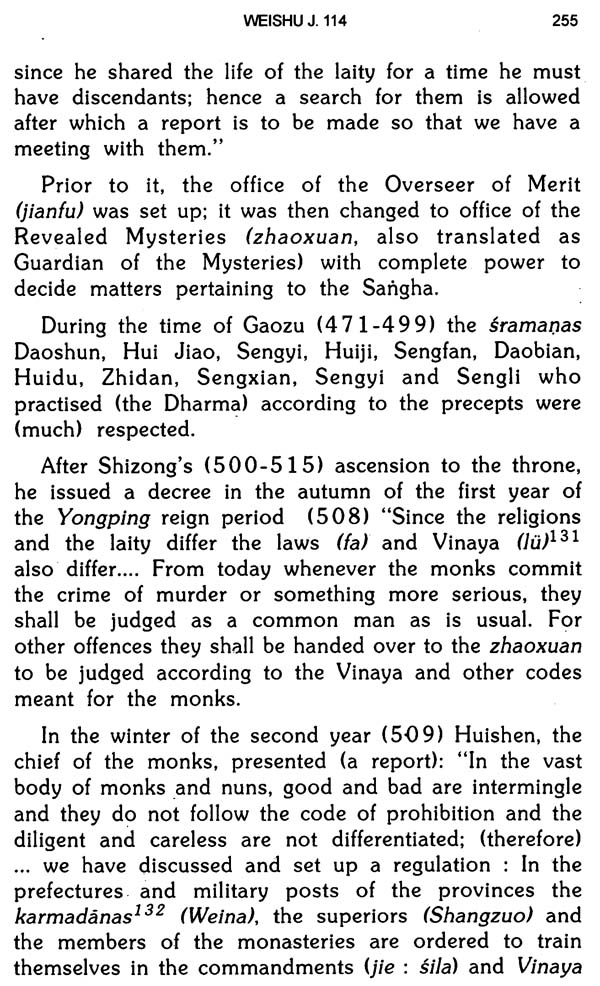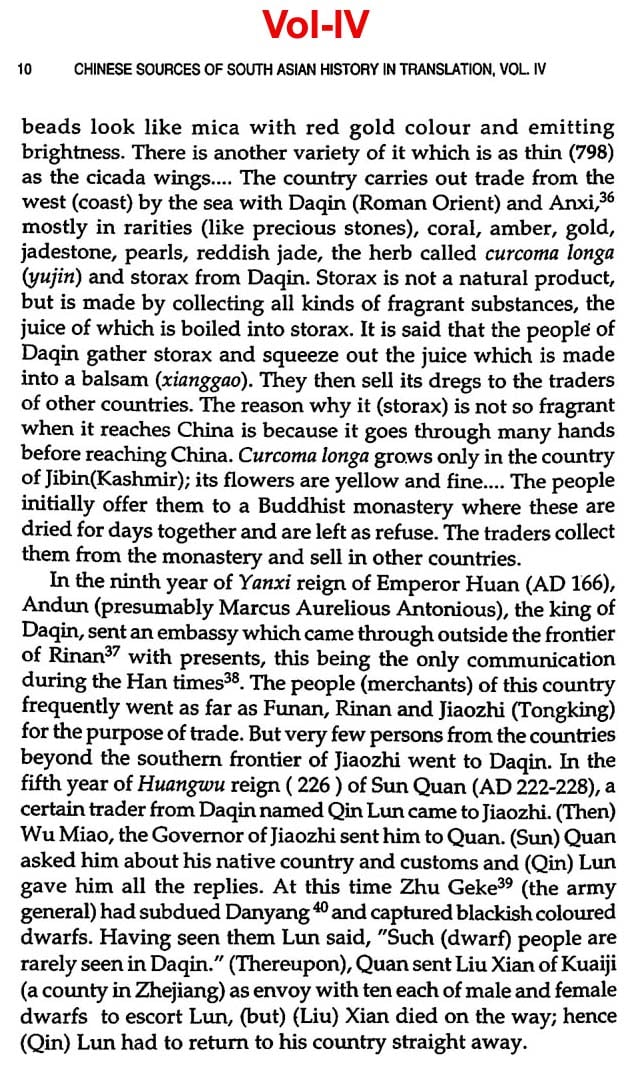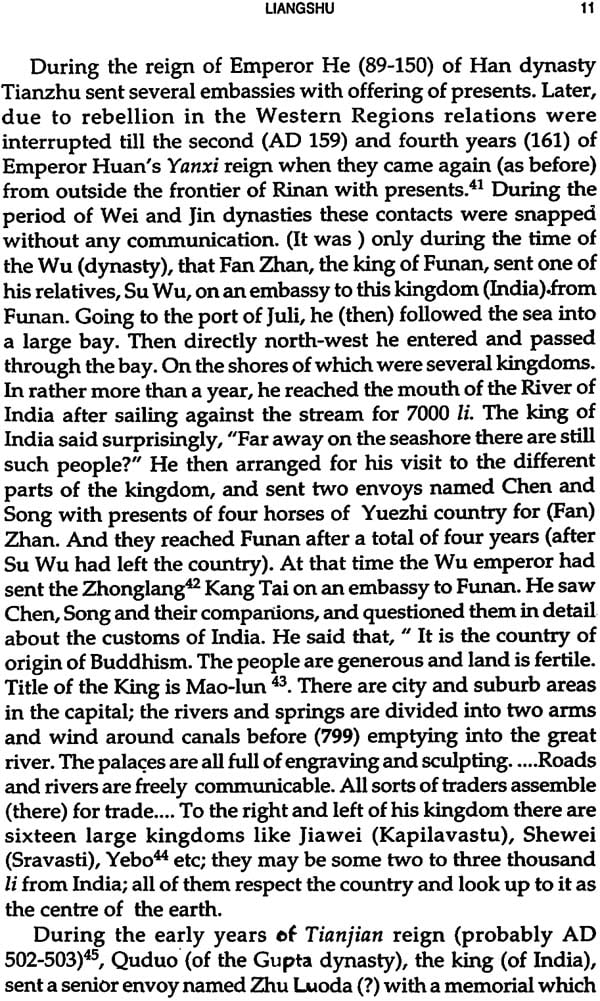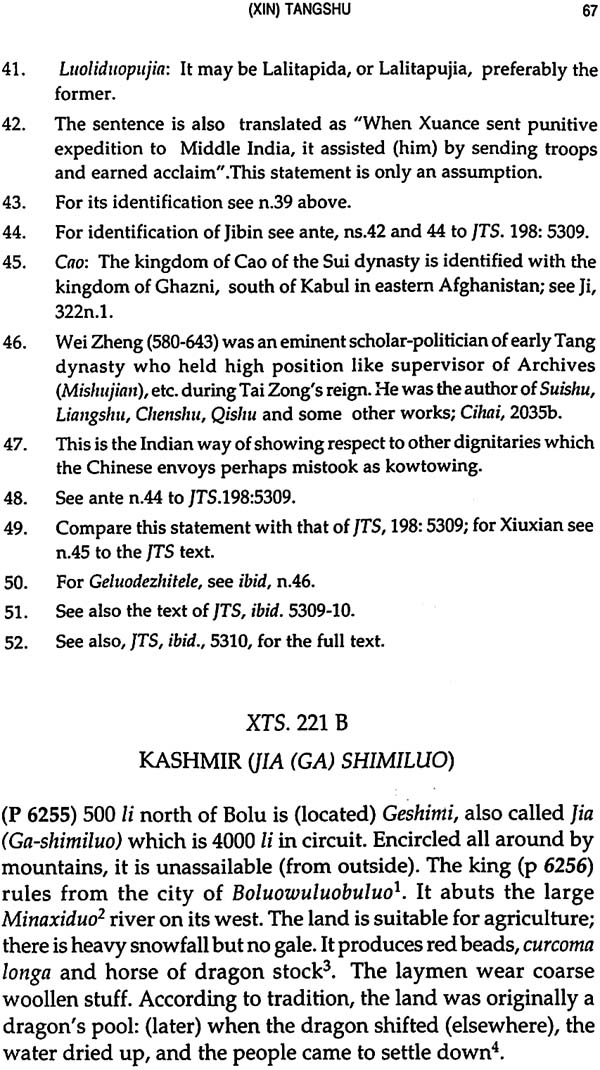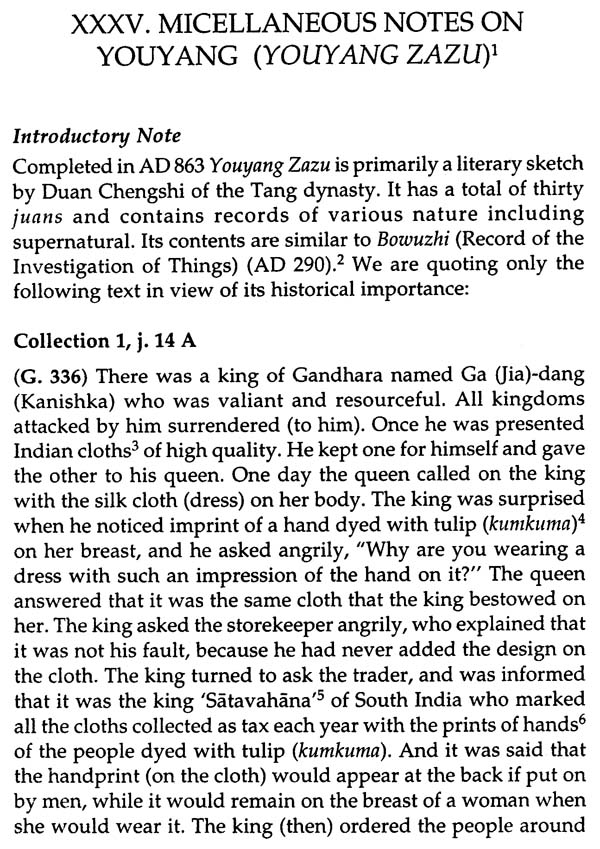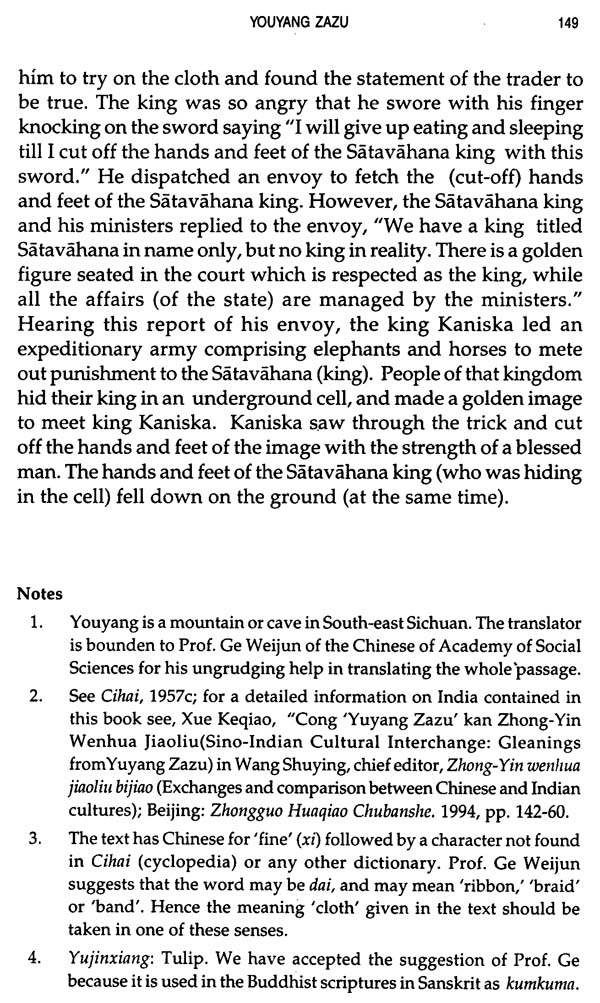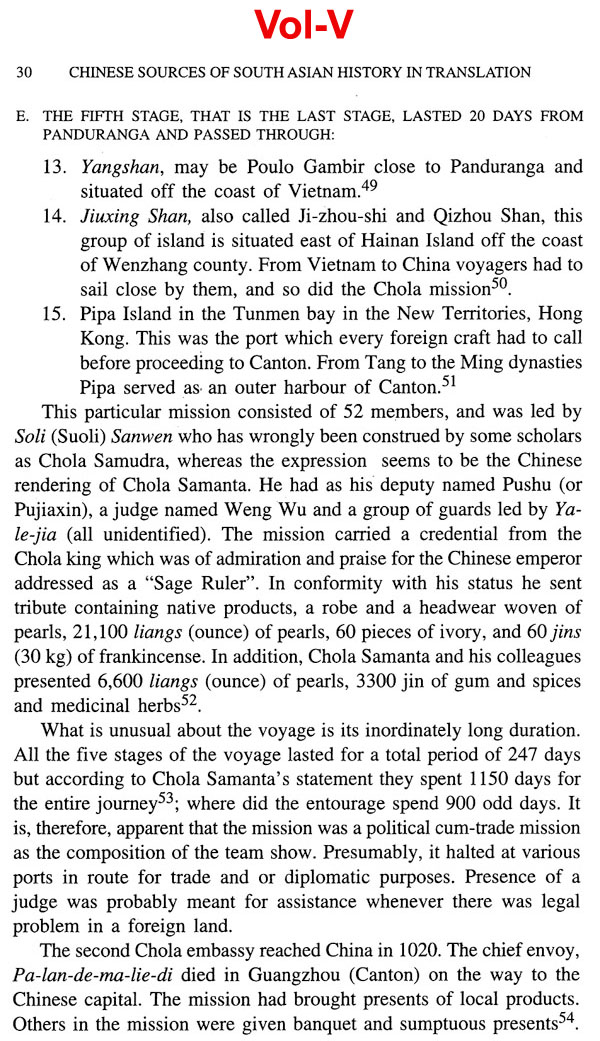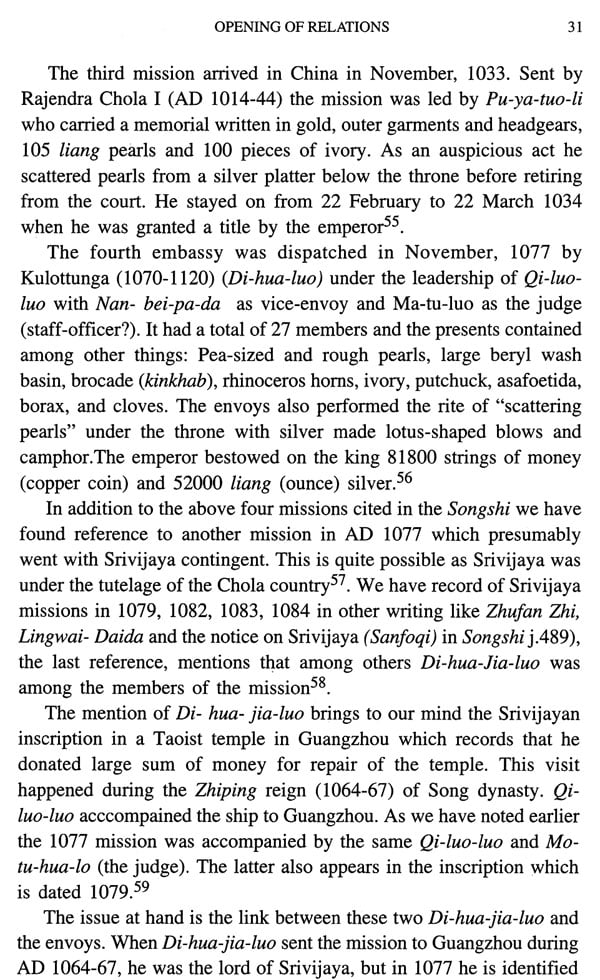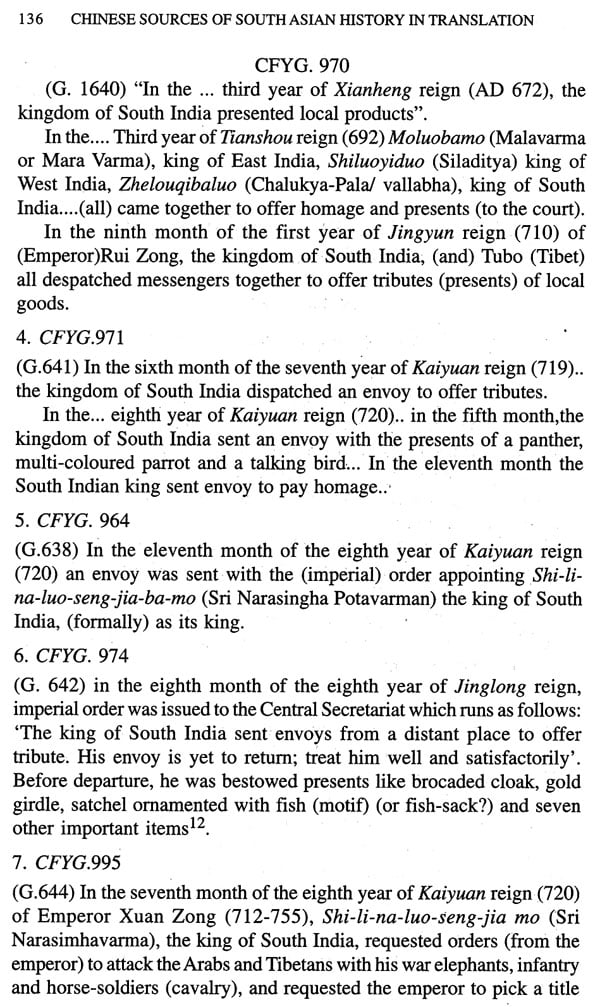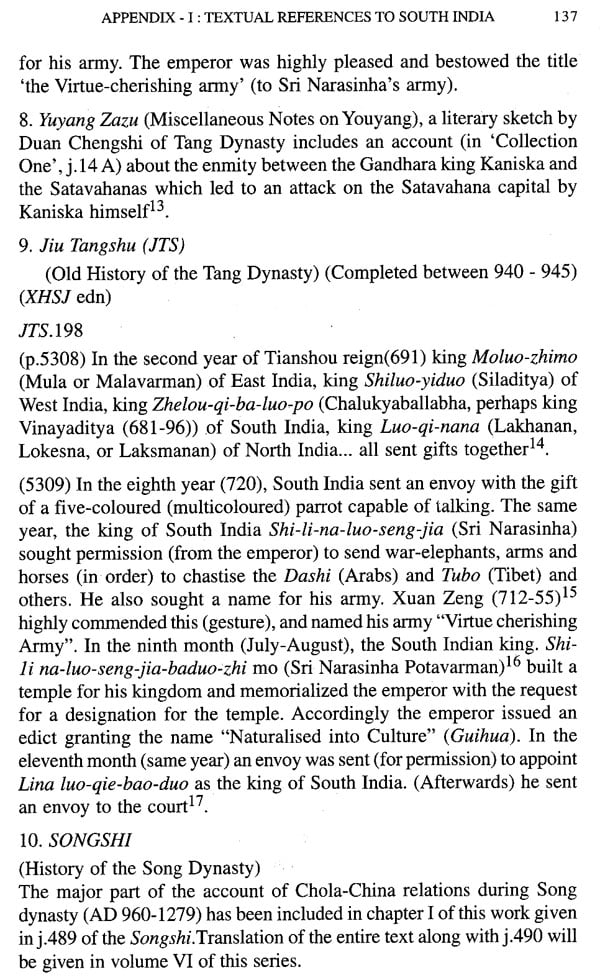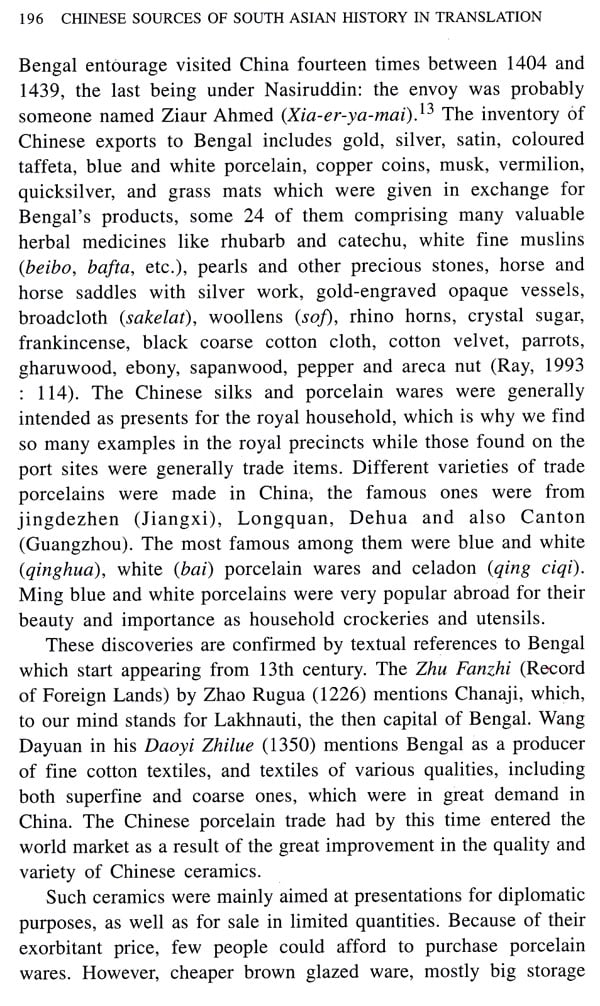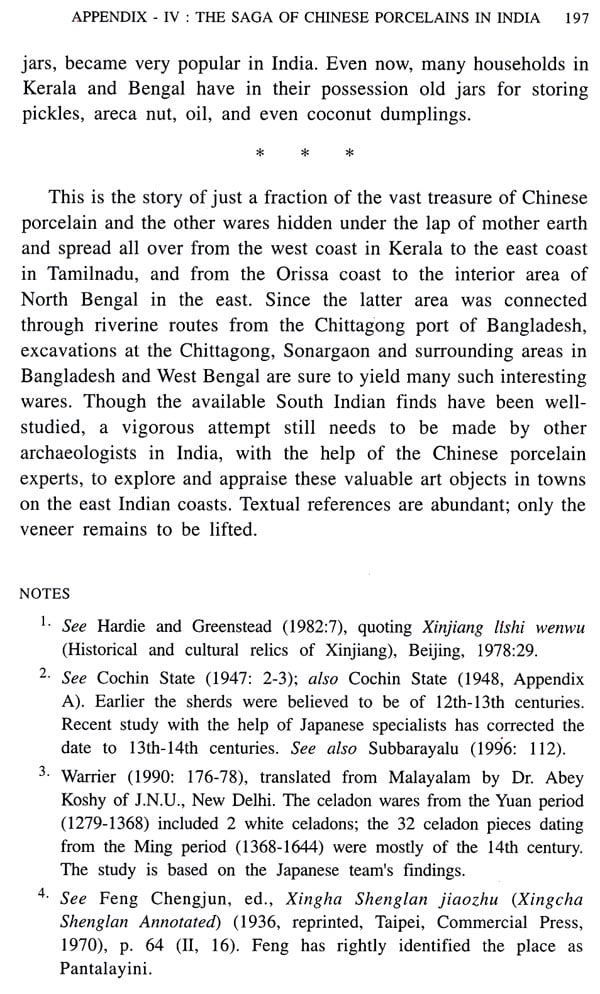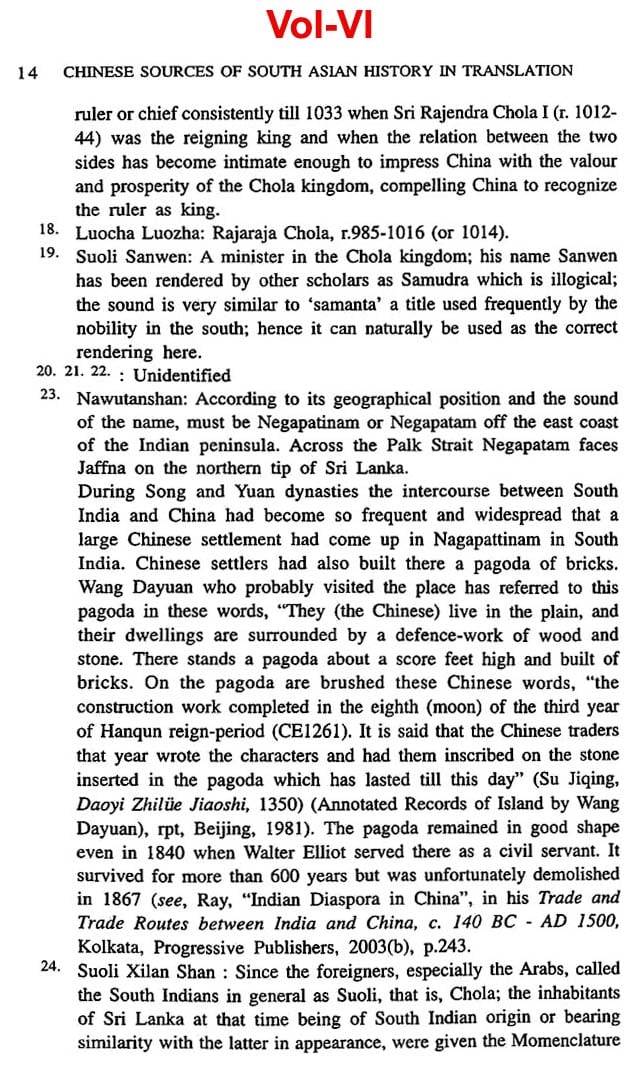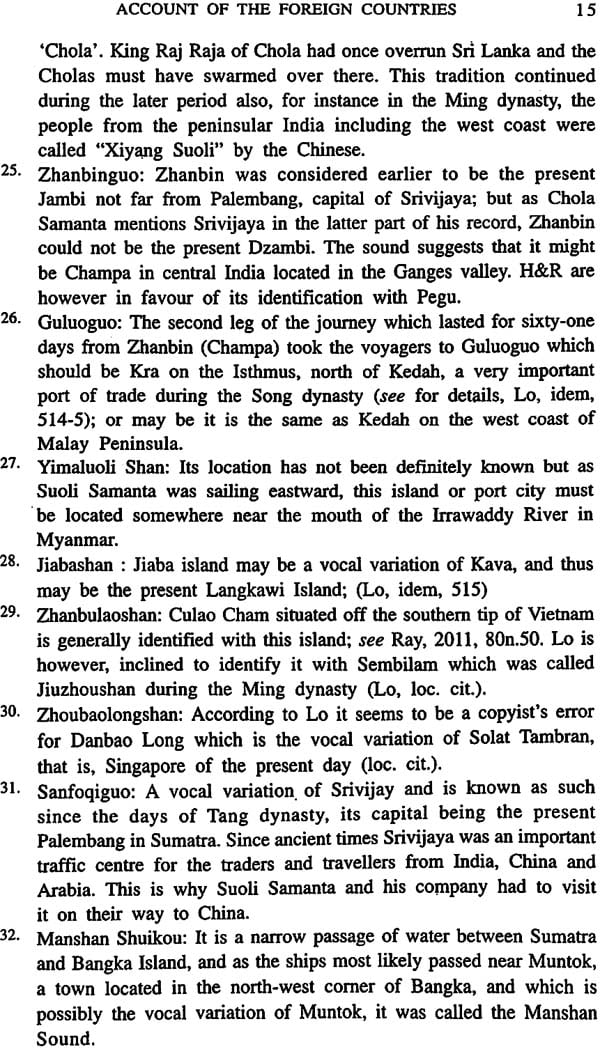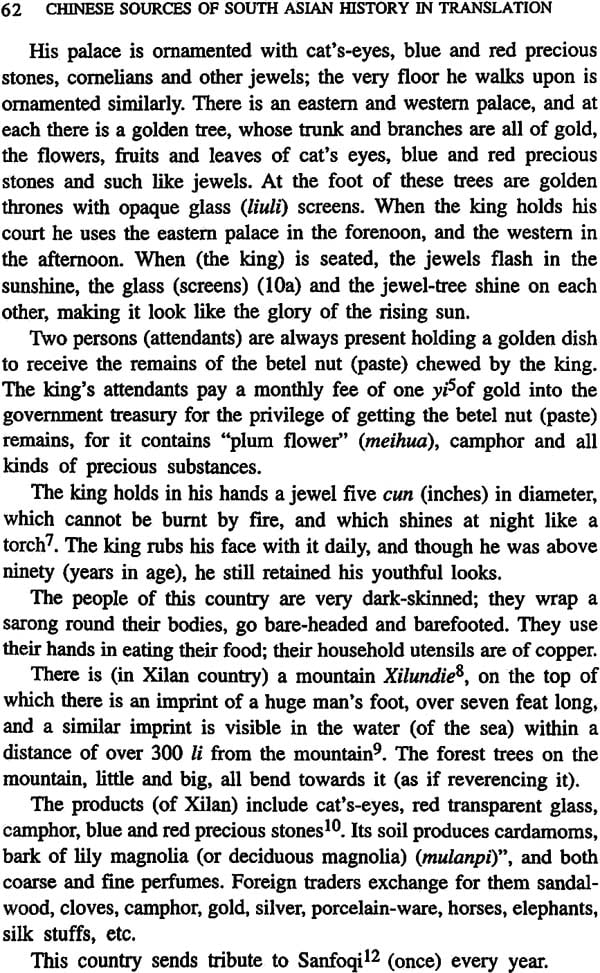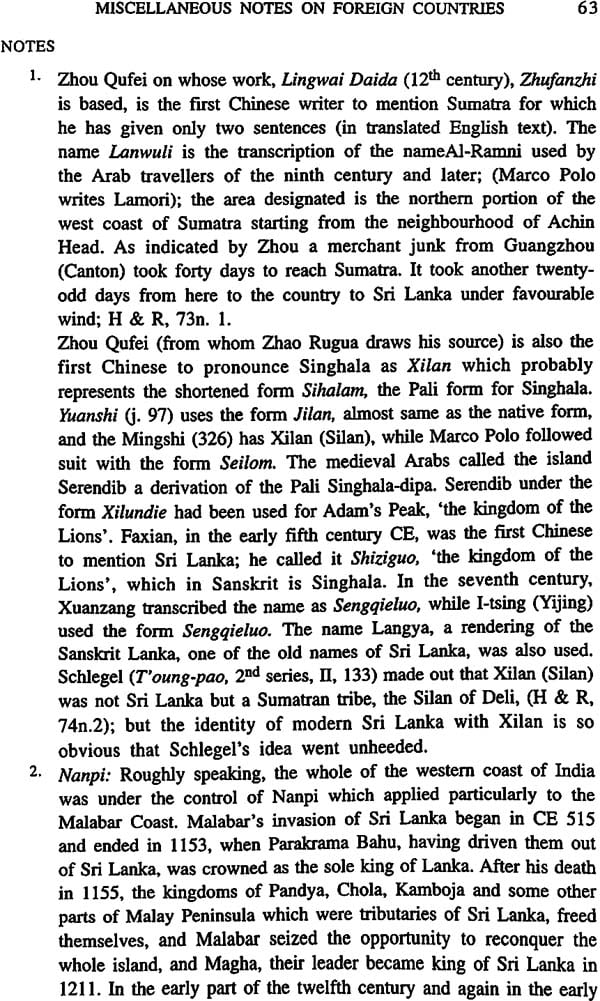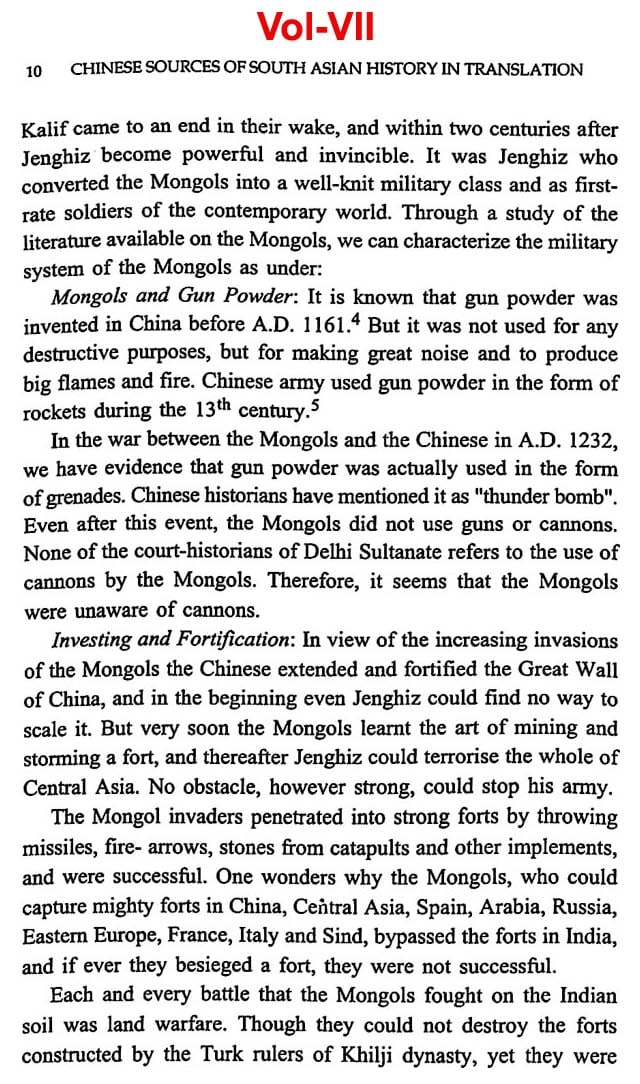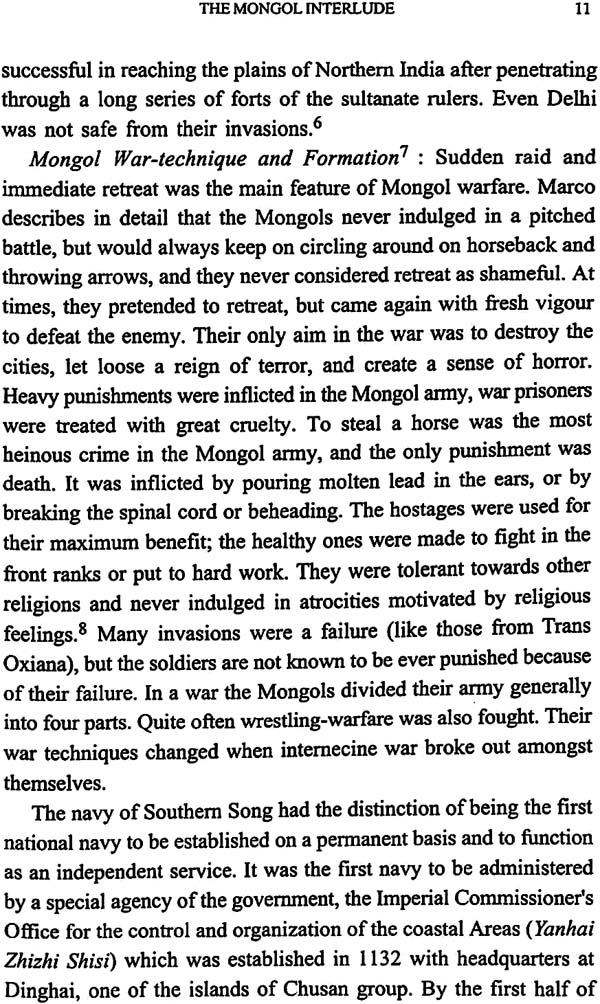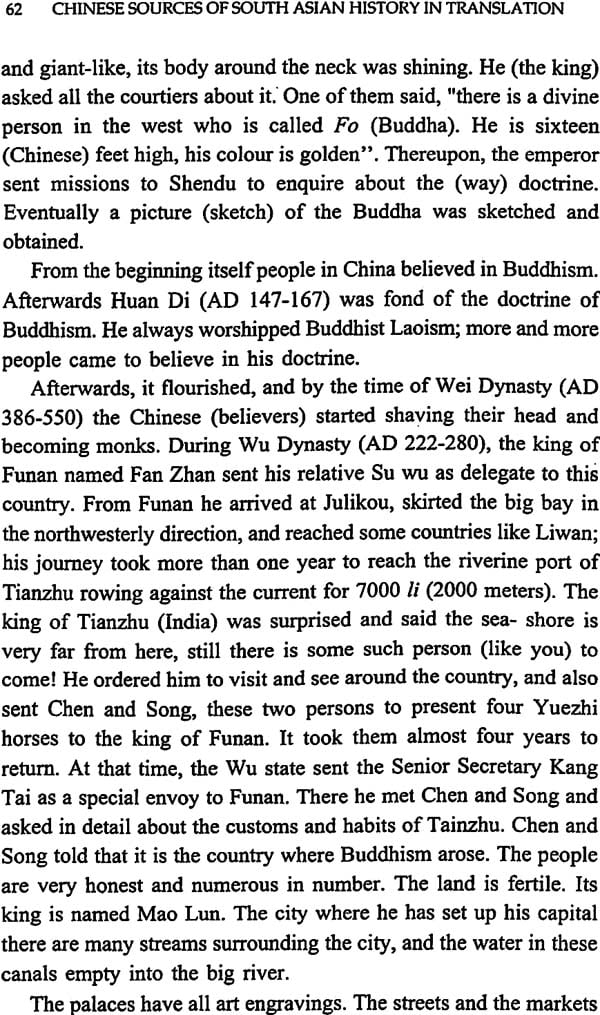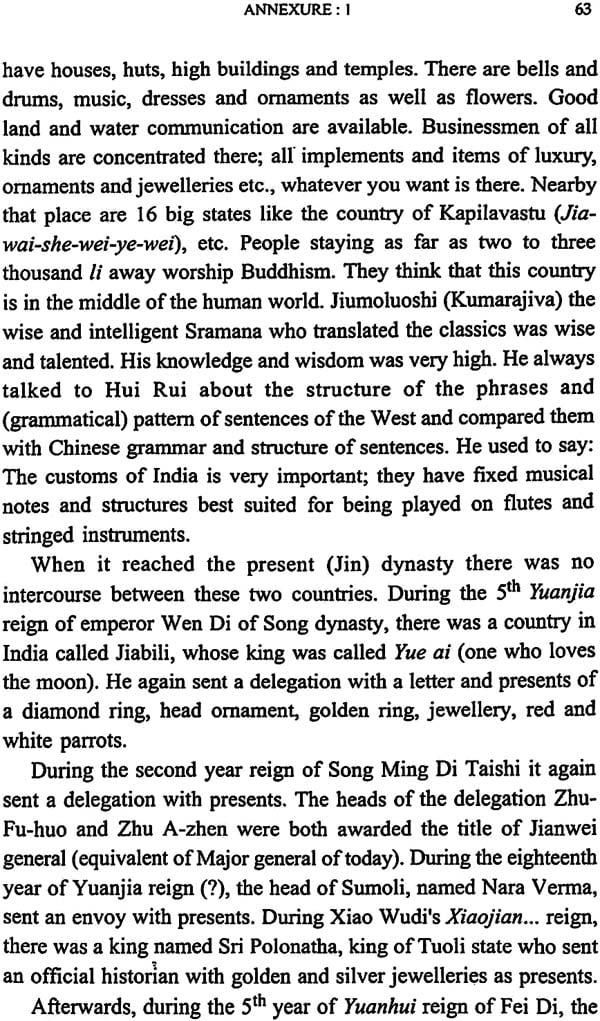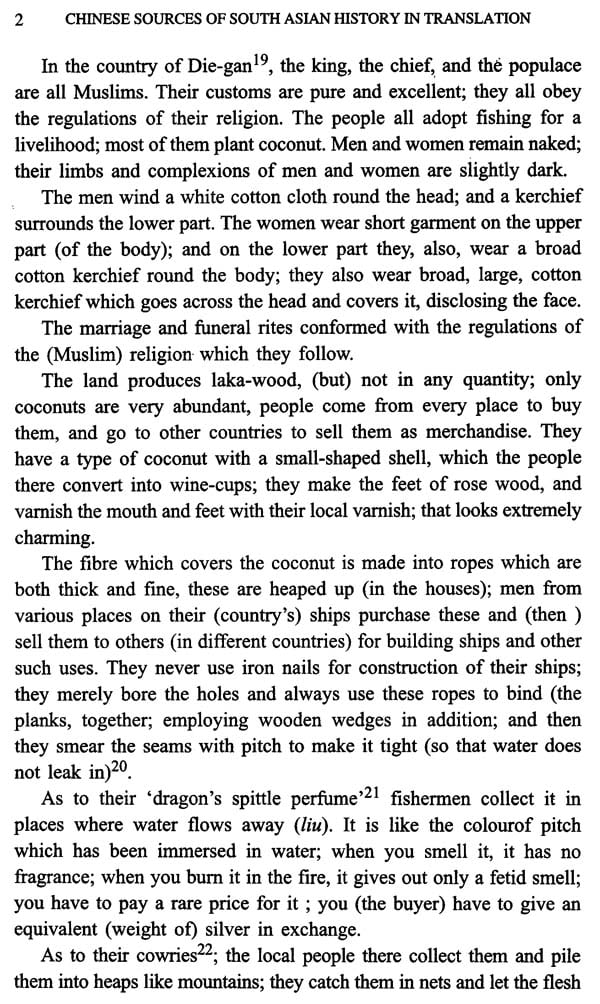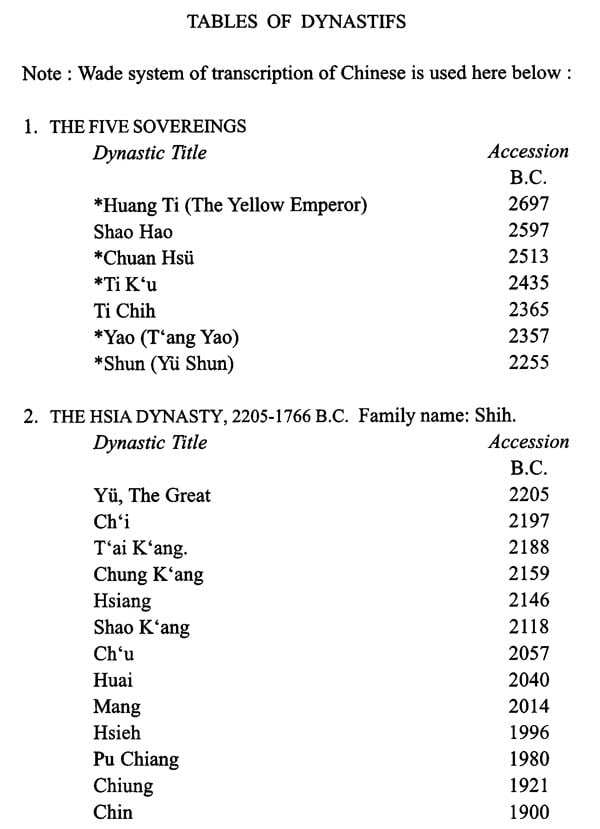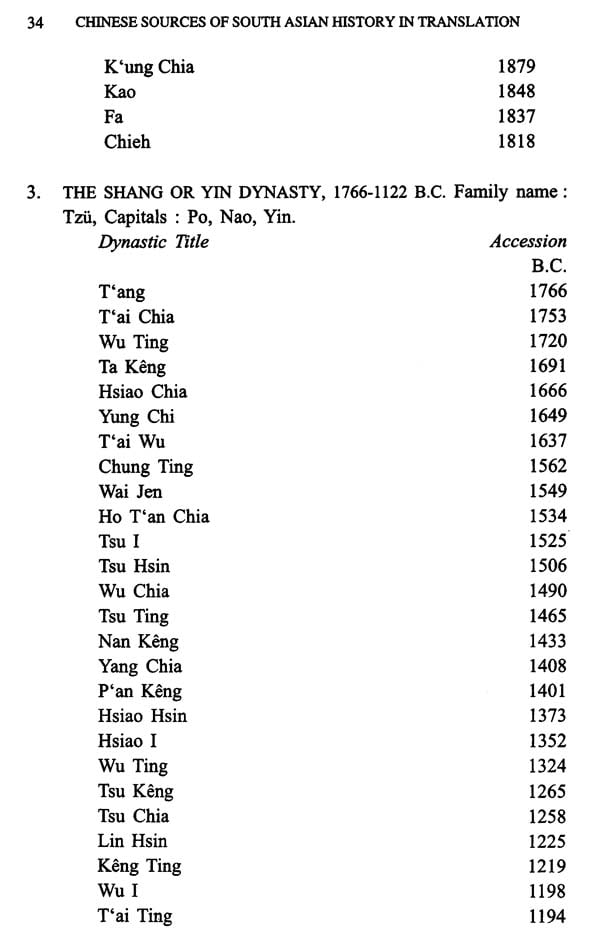
Chinese Sources of South Asian History in Translation- Data For Study of India-China Relations Through History (Set of 8 Volumes)
Book Specification
| Item Code: | NAJ997 |
| Author: | Haraprasad Ray |
| Publisher: | THE ASIATIC SOCIETY |
| Language: | English |
| Edition: | 2019 |
| Pages: | 1482 |
| Cover: | HARDCOVER |
| Other Details | 8.50 X 5.50 inch |
| Weight | 2.69 kg |
Book Description
This is the first volume in the series "Chinese Sources of South Asian History in Translation: Data for Study of India-China Relations through History". It can legitimately be called the first of its kind in the world. The present volume contains the notices, memoirs, biographies, basic annals of Chinese rulers and accounts of different nature from the official and unofficial histories, and records of flora, supernatural anecdotes and sundry matters. The earliest Chinese intercourse with the Southeast Asian states is also available here. A total of 61 entries of varying lengths from 13 important works from Shiji to Weishu have been translated with exhaustive notes and elucidations almost 75 per cent of which are made available for the first time to the scholars of ancient and early medieval South Asian history. The translated texts are evaluated in their proper historical perspective to provide new data and fresh interpretations. Translations are prefixed by notes on the authors and their works as well as introduction to the contents of the treatises from where the texts are lifted.
This and the volumes following it will prove to be essential companions for the scholars of India-China relations and a must read for other cultural historians.
This is the second volume of the series Chinese Sources of South Asian History in Translation. Entitled "Chinese Sources on Ancient Indian Geography", it comprises two texts on Historical Geography. The author has translated and annotated exhaustively the latest collated versions of the texts which will help the students of ancient Indian History and Geography in exploring some of the hitherto unexplored domains of ancient India. The first work, Kang Tai's Notices on Foreign Countries during the Wu Dynasty (AD 220-280) is a collated text of all available notices that go in the names of Kang Tai and other envoys and travellers whose writings are no more extant but are scattered in other collectanea. Collected over a number of years they give a coherent idea about the all-sea route passing through the Malacca Straits touching Ge-ying and Jia-na-Tiao (Ganadvipa), and reaching the Eastern and Southern India and may be the Asia Minor (Daqin).
The second work, The Commentary on the Water Classic (5th- 6th cent. A.D.) does not only record the geography of Central Asia, but also acquaints us with profuse information on the countries nearby, and India, Afghanistan and other areas outside China. The author shows knowledge of many Indian cities of North, South and Eastern India, and gives the impression that to the Chinese the entire Indian continent constituted one geographical and political concept.
Both the works are important additions to the libraries of bibliophiles and will prove to be sine qua non for the Indian orientalists researching for data on our past.
This book reconstructs an interesting chapter in the history of Buddhism in China, and how China absorbed and internalised the teachings of Buddha. It forms the third volume of Chinese Sources of South Asian History in Translation.... Subtitled "Buddhist Trilogy" the work includes three texts not studied thoroughly before in India. Gaoseng Zhuan (c.530A.D.) by Hui Jiao affords us an insight into how the major Buddhist proselytisers from South Asia carried out the Herculean and hazardous task of disseminating their creed in a foreign and unknown land under hostile conditions. By the time we come across Luoyang Qielan Ji (547) by Yang Xuanzhi, Buddhism had already become a flourishing creed in China, its capital, Luoyang, being turned into a picturesque city dotted with Buddhist temples of all descriptions scattered all over the city. The author's inclusion of travels of Song Yun and Hui Sheng to Udyana and Gandhara in 518 (map provided) is an important contribution.
The last text in the book is the piece on Sakyamuni, the Buddha, included in juan 114 of the History of the Wei Dynasty (Weishu) (554) by Wei Shou which provides the only official account of Buddhism ever included in a dynastic history of China. It sums up the growth of Buddhism in China through various stages of ups and downs. Less than a century thereafter came the Tang dynasty rightly called the Golden Period of our relations which constitutes the fourth volume of this set.
By the time a reader finishes reading this tome he will be convinced of the historical process under which Buddhism became a religion and philosophy encompassing all aspects of Chinese life after overcoming all vicissitudes.
Subtitled "The Golden Period of India-China Relations" the work contains extremely important data on China, central Asia and India till the middle of the tenth century AD. Of special interest are the personal relations between Emperor Harsavardhana and the Chinese monk Xuanzang (Hiuen Tsang), the remark of the Indian Emperor after meeting the Chinese pilgrim, details about some of the accounts given by Wang Xuance, the Chinese envoy to India whose written accounts are lost now, as well as the political relations between the states of Kashmir, Tibet vis-a-vis China, and so on.
A must read for scholars and students of ancient and medieval history of Asia.
The content and methodology adopted for this volume is not the same as the earlier ones. It gives the local history of the various south Indian states based on the primary Chinese sources collected during the past several decades. A gist of the textual references in other Chinese works concerned with the southern part of India has also been provided. The influence of Buddhism which strengthened our linkage and also expanded Chinese sea-power have also been given in nutshell. In addition a short textual reference to south India in Chinese writings has been given in the Appendices which are five in number. The previous volumes of this series have received raving praises and are regarded as valuable sources for the scholars.
Trade expanded simultaneously with the improvement of Chinese sea-power and handicrafts; quality of silks and porcelain wares was perfected creating world-wide market. The present volume starts with the (New) History of Tang dynasty, and ends with the private historical writings which in many ways supplement the official history, namely Miscellaneous Notes on Foreign Countries (Zhufan Zhi) by Chao Jukua (1226). By this tune we get detailed accounts of inter-state relations between the south Indian state Chola and China. It also contains valuable accounts like Comprehensive study of Documentary Evidences (AD 1322) and other treatises.
The previous volumes of this series have received raving praises and are regarded as valuable sources for the scholars.
This volume seven of the series which is titled "From Nationalism to Foreign Occupation : The Mongol Interlude" evidently ends with the fourteenth century A.D. The economic life in China was controlled by the central government. Between the Tang (A.D. 628-907) and the Yuan (Mongol) (A.D. 1206-1368) dynasty amber, jade and embroidery improved tremendously.
Apart from the above historical texts we have utilised the private historical writings, for instance Wang Daynan's Daoyi Zhilese. We have also included one rare document on India with the hope that it will reach wider readership.
The previous six volumes of this series have received raving praises and arc regarded as valuable sources for the scholars.
The author very efficiently published seven volumes before this volume. This volume mainly deals with two oceanic Islands-Laccadive and Maldives. This volume will enhance the knowledge of the region. Professor Haraprasad Ray completed the manuscript for its publication when he is physically unable to move. His scholarship for this volume, although thin in size, will help the researchers and scholars in the field.
The Previous volumes of this series have received raving praises and are regarded as valuable sources for the scholars.
A senior Chinese expert in India, Dr. Haraprasad Ray the author, has already established-his reputation as one of the very few Indian scholars dealing with India-China relations. He has contributed to a number of international seminars in Germany, Hong Kong, China, the U.S.A., London, Paris and other places.
Dr. Ray has already authored some books and more than five dozen articles published in scholarly journals both in India and abroad.
Dr. Ray was Sino-Tibetan Research Scholar in Chinese at Calcutta University during 1953-56. In 1959 he joined the Ministry of Defence as a Chinese language expert and held responsible posts. His service was transferred to the Jawaharlal Nehru University, New Delhi. After retiring from JNU in 1996, he was successively made Senior Fellow of the Society for Indian Ocean Studies and the Indian Council of Historical Research. Presently a Professor at the Asiatic Society, Kolkata, Dr. Ray is now engaged in exploring data on South Asian history from Chinese sources covering the period from the earliest till late 19th century.
This volume as well as the future ones evolve out of my twenty-seven years of teaching Chinese to the undergraduate and post-graduate students at the School of Foreign Languages, Government of India, and the Jawaharlal Nehru University in New Delhi. While its structure was formed by that experience, my intense interest in our great neighbour and the confidence reposed on me by my Indian and Chinese colleagues as well as by the doyen of Indology in China, Professor Ji Xianlin, inspired me to bring the task to pass.
In presenting the first volume of the Chinese Sources of South Asian History in Translation, the present author has not spared any effort to make it as exhaustive as possible within the limitation that a foreign Sinologist is subject to. No one is more conscious than this scribe of his limited knowledge and reading, and the resulting inadequacies in executing this herculean task of translating, annotating and editing historical data comprising information of diverse nature each different from the other. The nature of these Chinese classical texts can best be described in the following words on Banabhatta's structure and style, "very hard outside like a coconut shell, but very juicy and tasteful inside when broken into pieces."
We follow here the periodization adopted by Geng Yinzeng, i.e. the dynasty under which the works were completed; e.g. Liangshu covers the period A.D. 502-556, but was completed in A.D. 629 under the Tang dynasty. Hence it will be included in a later volume comprising the histories of Jin, Chen, Northern, Qi, Sui and Tang.
The Fuoguo Ji of Faxian (also known as Faxian Zhuan) and Da Tang Xiyu Ji of Xuanzang have been left out because translation (with critical notes) of these works by James Legge, S. Beal, Li Yunghsi and T. Watters (summarised version of Xuanzang's work) are already available in India. However, we may take up the relevant chapters of these works for critical study at a later date, as has already been done in the case of Xuanzang's travelogue in two articles.
Reading Guide
1. Guo has been translated in several ways, namely, 'country', 'kingdom' or 'state'; 'state' has been used in a general way and not in the modern political sense.
2. Short introductions on the authors have been provided with introductory notes to the chapters and sections translated.
3. Portions not translated have been indicated by three dots, and, wherever necessary, summaries of texts have been provided as links between two parts; these summaries have been placed under double brackets at both ends.
4. In the Contents, the names of works come first, followed by their translations in brackets; e.g. I. Shiji (Records of the Historian); while in the case of the translated texts, the arrangement has been reversed; e.g. I. Records of the Historian (Shiji). The Contents also give detailed list of titles with their juan numbers.
5. The Chapters (Juan) or parts thereof translated are given after the abbreviated forms of the works; e.g. SJ. 110, HHS. 88. etc. followed by the English translation of the titles with the Chinese originals in brackets.
6. The pages of the original Chinese texts in their Zhonghua Shuju editions, unless otherwise stated, are given in brackets, and to avoid confusion, prefixed by 'p' in the beginning of each work.
7. A Brief Chinese Chronology from the earliest up to the last dynasty covered in this volume, has been provided. 8. The Chinese texts give the traditional lunar dates of imperial reign periods, etc.; their corresponding Gregorian calendar dates are given in the translated texts in brackets; distance, identity of geographical names, weights, measures, etc. are also given in their modern forms in the texts. Those requiring explanation have been given in the end notes.
9. The Chinese lunar months, lst month, 2nd month and so on, normally begin one month or so later than the Gregorian; i.e. 1st month will generally coincide with the last week of January or first week of February. Readers may refer to the Chronology given at the end of Cihai, Ciyuan, or consult A Sino-Western Calendar for Two Thousand Years, 1-2000 A.D., Commercial Press, Hong Kong, 1961, for details.
10. The Pinyin system of transliteration has been used for Chinese geographical terms and proper names. For those not familiar with this system, a comparative table of Pinyin and Wade-Giles system has been given along with Nagari and Bangla equivalents for the convenience of Indian scholars.
11. Seven maps have been attached to give the readers a concrete idea about China's territory and its historical expansion, as well as extent of dissemination of Buddhism from early first century to 5th century A.D. Some of the names on the maps are in Wade-Giles system of transliteration adopted in most of the historical texts.
The two texts on historical geography translated in this volume are rare works and were procured with the good wishes and efforts of various friends. The first one, the Kang Tai Wushi Waiguo Zhuan Jizhu, is a collated and annotated version of all available notices that go in the names of Kang Tai and other authors whose writings are no more extant and are available only from other collectanea. These scattered quotations were collected over a long period by the late Professor Xu Yunqiao (Hsu Yunts'iao) and published by the Institute of South-east Asian Studies, Singapore. Professor Xu had also added notes wherever possible. In my translation I have updated them and added additional notes. This work was collected for me by my ex-student Mr. S.R. Lamba, former Assistant Director of the A.I.R.
As for the second work, the Shuijing Zhu, Professor Geng Yinzeng who used a Qing dynasty edition has omitted in her Collection some of the portions from the chapters on India (j.1 & 2) and the adjoining areas. But I did not think it worthwhile to embark on translation without having before me the entire texts of both the juans. After a long search I could lay hands on the entire work through the efforts of my young friend, Dr. R.K. Rana of the Department of Buddhist Studies, University of Delhi. Dr. Rana procured from Taipei the present rare version, a critical edition collated by the late scholar Mr. Wang Guowei. Although not properly punctuated, this version titled Shuijing Zhu Jiao is important for getting at the correct readings since the editor has given other readings also. L. Petech's Northern India according to the Shuiching-chu has also been of considerable help for explanation of some of the nearly undecipherable expressions.
For a better appreciation of the importance of these two works we have added introductory notes to each of them with their translations.
We have great sense of relief, short of satisfaction, in being ableo complete translation of these three Buddhist texts. In case of GSZ only ten biographies could be translated, three of them being quite long, each almost as big as a monograph in its translated form. We had to rationalise and restrict the content of each volume in view of the total project extending to 19th century, about one-third of which will be completed with the present volume. If the present author survives after completing the entire scheme, the remaining part of the GSZ may be taken up again. For the same reason one chapter (ch-II) of LYQLJ has been disposed of with a short note (Geng Yinzeng has omitted the entire chapter). From WS. 114 the part related to the Buddha, which comprises about sixty per cent of the entire chapter-Juan has been translated.
The author has taken great risk in venturing upon the hazardous task of translating these religio-historical texts written in highly stylised literary form couched in Buddhist technical terms, translated and transliterated into Chinese, which, indeed, is a daunting task for a translator.
GSZ (c. 5 3 0A.D.) has been placed first in this volume as its biographies afford us an insight into how the major Buddhist personalities played their role in the dissemination of their creed. The second, LYQLJ (547) gives a graphic and picturesque details of the temples and monasteries (Sangharamas, transliterated as Qielan in Chinese), after Buddhism had become a part and parcel of Chinese life. The last one, Ws. 114 (Shi Lao Zhi) (554) sums up the initial stage, the ups and downs and growth of Buddhism in China as seen by an official historian. However, the portion on Taoism has been omitted for obvious reason. Less than a century thereafter in 618 came the Tang dynasty which is legitimately called the Golden Period of Indo-China relations; this period will constitute the next volume of this series.
The author is indebted to various scholars and friends in India and in China, specially to Dr. R. K. Rana of the University of Delhi who had ungrudgingly provided dictionaries and rare books that facilitated our work immensely. To Ge Weijum, Wang Bangwei, Wang Shuying in China, and over and above, to Ware, Wright, Zurcher and Link whose articles and books especially the translations of the Buddhist works have shown me the way. Finally, I shall consider my labour worth the candle if it is of some help to the scholars pursuing Buddhist studies. For their convenience various glossaries etc. have been added.
We are extremely happy to be able to present to the scholarly world the fourth volume of our project which aims at providing data on ancient and early medieval period of India-China relations from hitherto or little known Chinese sources which are both reliable and authentic. This involved the stupendous task of getting at the source materials from the large number of historical and miscellaneous writings in Chinese language in literary style. After selection of these sources-known, little known and unknown-the passages are collated, and then translated and annotated so as to bring out the historical and socio-political significance for the benefit of the inquisitive scholars and students.
In this volume, besides the relevant accounts from the official histories, we have used the additional data from Geng Yinzeng's collection which has initially formed the nucleus of our venture, as well as the volume IV of Zhang Xinglang's collectanea which is the pioneer work on the subject.
Starting with Liangshu and Suisshu we have tried to accommodate the major works pertaining to sixth century AD through tenth century. However, Cefu Yuangui, completed in early eleventh century during the Song dynasty, has been included in the volume, because it provides important reference materials about the past rulers, particularly the Tang emperors. Total works included are seventeen in number, many of which are translated for the first time.
I may mention here that it is the first time that an attempt is made in India to translate the old Chinese classics like the official dynastic histories as well as the non-official historical and semi-historical writings, travelogues, etc. in search of historical data on South Asian countries like present-day India, Bangladesh, Pakistan, Nepal, Sri Lanka as well as Myanmar and other states of South-east Asia. A lonely man in this exercise, I am trying to grapple with the intricacies of ancient Chinese, unravelling from among the vague and now-defunct expressions, the geographical, historical and other relevant data for the benefit of the concerned scholars and students.
While working on this project, I have the good fortune to consult a profound scholar like Professor B.N. Mukherjee, who, inspite of his failing health, has always suffered me in his reading-room and solved intricate problems of ancient Indian history. My friends like Professor Ge Weijun (CASS) in Beijing has always helped me ungrudgingly. Professor Ma Gang, the former visiting Professor at the Visva-Bharati helped me in translating some of the passages in this volume. I am beholden to the Asiatic Society for all the assistance and encouragement extended to me all these ten years and more in carrying out my work smoothly. I also extend my whole hearted thanks to Mr. Dilip Sen of Datacom for patiently helping me in typing and correction.
We have a sense of relief, a sort of satisfaction, in completing four volumes of the series in a little more than eight years despite limitations like scarcity of resources, tools and library facilities. The translator owns the sole responsibility for all the mistakes and inadequacies that may have cropped up in the book.
We have great pleasure in placing before the scholarly world the volume V of our project Chinese Sources of South Asian History in Translation : Data for Study of India-China Relations through History. Titled "Socio-Econo-Political Relations between South India and China, AD 502-1620 : With emphasis on the Fifteenth century AD", it is specially meant for the teachers and students of south Indian history who may find here some interesting facets in the long history of friendly relations between south India and China from ancient through medieval period. Care has been taken to collect data available mainly from the writings of Chinese historians and travellers who were keen observers of men and society. The content and methodology adopted for this volume is different from the earlier volumes in so far as it assays to unfold the local history of the various south Indian states based on the primary Chinese sources collected over the past several decades. The translation of the texts used are not given in this volume. For this the readers have to wait for publication of the subsequent volumes. However, a gist of the sources have been given in the Appendix - I. The work deviates from the histories of the region usually based on secondary sources where local sources in Chinese are unavailable due to language barrier. We have collected, collated and analysed the original primary data in Chinese and compared them with the existing historical treatises of the region in order to check their reliability and reformulate or revise the established facts. The four other essays in the appendices -are included in this volume in order to give detailed information on some of the connected subjects both at the macro and the micro levels. We are conscious of our shortcomings inherent in the treatment of historical material by a linguist who is not a historian by training. However, this inadequacy has freed us from the shackles of following any school or being subject to any hangover or prejudice. I cannot help expressing my gratitude to my south Indian friends in the preparation of this volume, the foremost among whom is Professor MGS NaraSTanan who along with his entire team of teachers and scholars of the department of History, Calicut University, helped me with material and advice since the year 1980 when I first visited south India in search of data and on-the-spot study. I have also profited from the suggestions of Professor J. Stephen of Visva - Bharati. I am grateful to all of them. Finally, I also extend my whole hearted thanks to Mr. Dilip Sen, Principal of Datacom Computer Education and his able assistant Ms. Nupur for their faultless typing which is very rare in Kolkata. However, the author owns the responsibility for mistakes that may have occurred in the book.
The Sixth volume of the series Chinese Sources of South Asian History in Translation has been completed amidst trying condition, but we have not been deterred by adverse situation and finished the job during the schedule period itself and this itself is a matter of great satisfaction and relief for us.
It may be worthwhile to note that Zhulian, the (Chola Country), has been mentioned as Zhunian in some works here for reasons unknown to us, it may be, it was pronounced as such or most of the visitors mistook the word as Zhunian. There are some Indian names like Puyatuoli whose original form we could not trace out.
After the fall of the Tang, trade along the Silk Roads declined, and it revived only with the rise of the Mongols. During this time, China was a "lesser" empire and could neither dominate the nearby oases and towns, nor protect caravans heading westward. In the thirteenth century, the Mongols erupted from Mongolia and created largest contiguous land empire in world history. They conquered and ruled much of the territory through which the Silk Roads traversed and encouraged the greatest flow of merchants, craftmen and missionaries across Eurasia.
During this period in the 10th century and after, Buddhism after reaching its apex in China, has remained stagnant and we do not hear about anything except transport of Buddhist texts from India and neighbouring areas by enthusiastic monks and the records left by them about China, the South-East Asia and Western India in the valuable accounts like Wenxian Tong Kao, Zhufanzhi, Fozu Tongji , Lingwai Daida and so on. We hope the present volume will fulfil the expectation of the scholars and students looking for fresh materials for their research.
Finally I register my grateful thanks to Sri Manik De and Sri Joydip Gupta for their patiently typing out this difficult document of India-China relations.
The seventh volume of the present series which is titled "From Nationalism to Foreign Occupation : The Mongol Interlude (end of the fourteenth century AD)" under the series The Chinese Sources of South Asian History in Translation, is now on hand for publication. The handling of materials related to China specially when you deal with the subject in English is tough enough for a non-English man. We are foreigners for both the English and the Chinese peoples, hence in handling the task of translation from Chinese into English, we are confronted with the problem of double translation-first from Chinese into one's mother-tongue, and then into English. However after an experience of more than half a century of being engaged in translation from Chinese to English, it is my humble opinion that even to have a proper perspective of our own history, it is worthwhile to have an idea of Chinese history and culture, especially after the advent of Buddhism. In fine, after completing six volumes one no longer needs to emphasise the importance of this venture, and while offering this volume to the scholars and students we are happy to announce that the next volume will be ready for publication in a short run.
This volume relates to the same period as the previous ones, that is the fifteenth century AD. There are two interesting chapters, that is, the Maldive and its sister island Laccadive Islands which are included for the sake of enhancing our knowledge of the region.
We have also given the dynastic table as in other volumes for ready reference.
I am grateful to Dr. Satyabrata Chakrabarti, General Secretary and the Council for continuous support towards its publication. I am also grateful to the Publication Department for their help in bringing out the book.
This volume contains a detailed explanation of the geographical data found in the ancient Chinese texts named Kang Tai Wushi Waiguo Zhuan Jizhu and Suijing Zhu, the first of which was collected and collated from scattered sources by the late Professor Xu Yunqiao and published in Singapore, while the second work, a rare version, was procured from Taipei. Professor Haraprasad Ray, an eminent Sinologist, has made relevant additions to the notes of Professor Xu Yunqiao, and explained many terms used in these two very ancient texts. The work has a Chinese chronology and table of transliteration, which would be useful to the readers. Claudius Ptolemy is venerated as a great astronomer, mathematician, geographer and cartographer of the Roman civilization. The two ancient Chinese texts, mentioned above, make it absolutely evident that in ancient China both geography and, to some extent cartography, were highly developed by inquisitive travellers who, however, did not always mention the difficulties they had to face. This volume would be regarded as a highly significant contribution to the geography of ancient India.
Professor Haraprasad Ray is a senior Sinologist who has been writing highly valuable books on Chinese sources of South Asian History. His aim is to unravel the Chinese version's of some special features of India civilization. such as Buddhism, which was disseminated in China long ago. Perfect knowledge of the Chinese language is a sine qua non for this purpose. Professor Ray mastered this language, and deeply Studied what the ancient Chinese historians wrote about Buddhism in their country from the downfall of the Han dynasty in B.C. 206-220 onwards. These writings of inestimable value are presented in this volume in the form of biographical accounts called Gaoseng Zhuan. In which the Chinese versions of the Buddhist scriptures and the biographies of those who preached them in alien situation are incorporated. This work therefore, is indispensable for students of Chinese Buddhism in troubles times, when the Chinese civilization was achieving significant growth through the simultaneous cultivation of competing religious, philosophical and ethical systems like Confucianism, Taoism, and Buddhism. Gaoseng Zhuan, as presented in this volume in translation, makes it evident that such great Indian Buddhist monks it evident that such great Indian Buddhist monks as Kumarajiva achieved considerable success in making Buddhism an inalienable ingredient of Chinese civilization. Many Buddhist preachers, about whom the Indian Buddhist tradition is dim, are vivified in this work. This work, therefore, is of great importance in Buddhist studies. It is indubitably a highly valuable publication of the Asiatic Society.
I am happy to write the Foreword for the series on Chinese Sources of South Asian History in Translation : Data for Study of India-China Relations Through History, Volume Four : The Golden Period of India-China Relations (6th Century AD-10th Century AD) by Professor Haraprasad Ray. I am very much tempted to quote the following excerpts from the Preface of this volume by Professor Ray : "I may mention here that it is the first time that an attempt is made in India to translate the old Chinese classics like the official dynastic histories as well as the non-official historical and semi-historical writings, travelogues, etc. in search of historical data on South Asian countries like present-day India, Bangladesh, Pakistan, Nepal, Sri Lanka as well as Myanmar and other states of South-East Asia."
I am sure the scholars, and researchers in the area will be immensely benefited by this volume. The Asiatic Society records its deep sense of appreciation to Professor Ray for his scholarly endeavour.
One of the most important aspects of study in the Asiatic Society has been cultivation of knowledge into the source materials on Asiatic Civilizations. As part of this major objective and in keeping with this rich tradition of research, Professor Haraprasad Ray, a Senior Fellow of the Society, has dedicated himself to the noble task of unfolding a relatively less explored area. For the last few years he has been engaged in the study of Chinese Source of South Asian History in Translation. This is the fifth volume added in this valuable series, which has specially focused on the relation between South India and China-in the context of socio-economic and political scenario which existed between 502 and 1620 AD. The justification of the present volume is well explained by the author in his Introduction- "It must be admitted that while South-East Asian History has profited most through comprehensive use of Chinese sources, South Asian history has suffered due to insufficient use of Chinese material". This gap may be understood in the reason that not many scholars in this field were sufficiently trained in Chinese language. In other words, the advantage of Professor Ray, being conversant in Chinese language, could make it possible, among other things, to elicit the relevant data and to interpret the relational aspects, especially in the area of trade and diplomacy. According to him there are enormous data base in Chinese records in this special field. It needs to be specially mentioned that the rich annexure that he has added to the volume will be of immense value to the readers.
I feel extremely happy that Professor Ray could carry out such a painstaking voluminous job of producing these important volumes braving the constraints of his physical uncomforts. I wish the academic world over will appreciate very much the relevance of such publications by the Asiatic Society and will also sympathize with Professor Ray so that he can complete the other title in this series at the earliest.
It gives me immense pleasure in placing the sixth volume of the series entitled Chinese Sources of South Asian History in Translation. Reiterating my observations recorded in the Foreword to the fifth volume, let me add that this volume includes the India-China relations and connected topics. It includes data not only from the official texts like New History of the Tong dynasty and History of Song dynasty but also from the private historical writings like General Account of Buddha and Patriarchs by Chi Pan (compiled between 1258 and 1269) which gives idea about the Chola and Malabar states of India and also China. It also contains valuable details from the Comprehensive study of Documentary Evidences (A.D. 1322) and other treatises.
I believe the scholars across all academic divides especially in social sciences, will accept the volume with the same importance that they have already shown to all the earlier volumes.
I feel extremely moved when I place this prestigious publication of Professor Haraprasad Ray, the eighth volume in the series on Chinese Sources of South Asian History in Translation because of the fact that Professor Ray completed this manuscript ready for the publication when he is physically unable to move from his bed. His scholarship for this invaluable project appears to be simply Imparallel considered by any standard of appreciation. In this long journey towards the completion of a mega project he has covered a wide range of source materials in understanding the Chinese sources of South Asian history. This volume is especially important for us in the sense that it covers two very known oceanic islands via., Nicobar and Maldives.
I hope the researchers and scholars in this special field of study would find this book of much help for their future guidance.
Preamble
In course of my teaching and research extending over more than four decades, I had often foundered for want of readily available source material from Chinese records which are massive, voluminous and overwhelming in dimension. While looking for original texts, I had to first scrounge for the texts all over the world and then set myself to translating them all on my own. This was an extremely excruciating and time-consuming ordeal. In this process, I had initially done translation of some medieval documents in connection with my doctoral dissertation on fifteenth century Bengal.
The demand for embarking on such an enterprise became irresistible. My students, research scholars, young historians in India, and friends from China encouraged me. But the problem of locating the Chinese records scattered all over China remained the only snag. This problem was eventually solved by the publication of an exhaustive compilation by Prof. (Ms) Geng Yinzeng of Peking University in 1994. But heavy teaching assignments at the University and my preoccupation with fifteenth century India-China trade and diplomacy (both Northern and Southern India) forced me to keep the project pending till my retirement. Award of fellowship by both the Indian Council of Historical Research and the Asiatic Society, Calcutta(Kolkata), in succession gave me the fillip to initiate this ambitious project.
Aims
The main purpose of this massive project is to translate the materials on South Asian history from Chinese historical writings for the benefit of the scholars of ancient and medieval history. For this purpose, I made a beginning with the Records of the Historian (Shiji) which is the earliest historical treatise available till date. This work was completed around 90 B.C. by the first and foremost imperial historian, Sima Qian (145-90 B.C.). He laid down the principle and pattern of writing dynastic history.
Such a highly stylised work written in old Classical Chinese, has to be approached with great care. It covers a wide gamut of events starting from the hoary past to about 99 B.C. (Former Han Dynasty), and encompasses China and the neighbouring countries. The work includes geographical names (now defunct), locations and historical personalities, and many other bewildering varieties of data. The decipherment, elucidation and clarification of all such points need a lot of time, labour and cross references to determine their exact meanings. This is time-consuming and cumbersome. Despite these limitations, I have made considerable progress in translating data from this magnum opus as well as the works succeeding it, namely, Hanshu, Hou Hanshu etc.
According to my original plan, I started translating texts included in the Collection of South Asian Historical Materials from Chinese Sources (Zhongguo Zaijizhong Nanya Shiliao Huibian), edited by Prof. Geng Yinzeng of Peking University (1994). But, in course of my translation, I discovered that the editor has, at times, left out long passages from the original works, when inclusion of some of them, passages and even chapters, would have been of use to the study of ancient Indian history, as well as of India's contacts with her neighbours. Therefore, I decided to apply my own judgement, and started including detailed accounts wherever necessary. The accounts on the Xiongnu (Hun), the Yuezhi (Kushana) and the Qiang are some of them. This exercise consumed substantial labour and time, delaying the progress in translation work.
The Story
Some of the salient features of the materials translated may be summed up as under :
A.The Hun and the Kushana
The Northwest Indian and Central Asian panorama is extremely colourful and eventful. In this vast spectrum, the Xiongnu (Hun) and the Yuezhi or Da Yuezhi (Kushana) have played both constructive and destructive roles.
The fear of the Hun compelled the different states of China to build the Great Wall of China, but when the Wall failed to prevent the Hun invasions, the Chinese were forced to organise huge cavalry forces to contain them. The Chinese campaigns against the Hun brought the Chinese to the fringe of Northwest India, namely, Bactria, Ferghana, and other countries. The Hun were instrumental in hybridization of the Chinese race through marriage, mutual surrender and other means. They also forced the Yuezhi to migrate from the west of China to Northwest India, a branch of which was known here as the Kushana (Guishuang in Chinese), the people who are known for their contribution to the social and cultural life of India.
In course of my research, I got so many data on the Xiongnu and the Yuezhi that I felt it imperative to go into the origin of the words, Xiongnu and Yuezhi. Xiongnu is wrongly rendered into English as Hun. An intensive search has been made, and a tentative conclusion has been arrived at. It transpires that at some stage, the Chinese employed them as serfs and used the name Xiongnu in the sense of "brave serfs" (The Hun used to be strong and intrepid in comparison with the Han).
The title of the Xiongnu chief was Chanyu (also pronounced Shanyu). We accept Bailey's derivation of the word from the Old Iranian Xsavan meaning "king" : Xsavan was presumably corrupted into Chanyu or Shanyu through overlapping or transposition of the sound of the last part of the word (note 5 to the translated text of Shiji, j.1 10).
Similarly, the word Yuezhi which has baffled the scholars for a long time, is supposed to be connected with the word Kusha, which means "moon" in Tokharian language. The Chinese word Yuezhi meaning "the Moon clan" is a direct translation of the Tokharian. Later, the name was probably also pronounced Yuedi or Yaedi (Yaeti) due to historical reasons when the tribe moved into Bactria.
B. Evolution of Chinese Foreign Policy on the Highlands and the Steppe of Central Asia
The intra-regional and intra-ethnical relations delineated in Shiji and Hanshu demonstrate how the Chinese diplomacy developed through alliance, intimidation, war and, above all, by dint of the policy of 'loose-rein' (jimi) and 'kind treatment' (huairou) to win the hearts and allegiance of these nomadic people called the 'uncivilised foreigners' (shufan). It shows how the Chinese emperors had to change their conciliatory attitude to belligerence due to the perennial scourge of the Hun.
Other tribes who stood in awe of the Hun and were keenly aware of the Hun hostility against the Han (Chinese), did not cooperate with the latter in selling their excellent horses for fear of Hun retaliation. When the Chinese subdued the Hun and completely subjugated the Wusun (an ally of the Hun), the situation. turned for the better in favour of the Chinese court and the supply of the Central Asian "heavenly horses" continued uninterruptedly. All these ups and downs are described minutely by the historian, Sima Qian, who was a witness to most of the campaigns against the unruly nomads. His and others related accounts have been translated by me in detail for the benefit of the scholars.
C. The Kushanas in Chinese History
The chequered history of the Kushana in Central Asia and India is known mainly from Chinese sources; these are supplemented by Greek and other foreign accounts, as well as the coins and other relics available to us. The accounts of Kushana influence in the Central Asia and its friendship as well as encounter with Han China are given in the History of the Later Han Dynasty (Hou Hanshu) and other later dynastic histories from where the related chapters have been translated by me.
D. Introduction of Buddhism into China-the Earliest Date
Historians have so long believed that Buddhism was introduced into China during the later part of 1st century A.D. But clear evidences are now available about a Chinese scholar-official named Jinglu having received lessons in Buddhism from a Kushana (Da Yuezhi) prince or official in 2 B.C. The story has been repeated in later histories also, giving it a stamp of authority. We have collected and translated them.
As already explained in the preceding volume (No. 1), my aim under this project is to provide data to the scholars of India-China relations through translation of and annotations to the hitherto known, unknown and little-known records on South Asia in the Chinese writings, mainly historical, and then collating these with the results of studies and archaeological discoveries in India, China, Central Asia and elsewhere. The results of this endeavour will enable the researchers to delve into the political contacts and conflicts, commercial exchanges and cultural intercourse between the countries of this vast area.
With the development of the kingdom and opening up to the outside world through explorations, political contacts and military expeditions, the Chinese gathered extensive knowledge of their neighbours far and near. In one such exploration Zhang Qian the envoy of the Han Emperor Wu (140-87 B.C.) reached the fringe of the then north-west India. At Bactria (Daxia) he heard about India (Shendu). Little did Zhang Qian and his emperor realise that this "hot and humid" country was to influence almost every aspect of Chinese life during the next thousand years or more. Busy traffic across Asia along the Silk Road reached an unprecedented scale. The Han court used to send dozens of missions to the western countries (as the Central and South Asian kingdoms were known to them), and these latter countries like the Roman Orient, Persia (Iran), India, the Arab Empire and those in south-east Asia kept on sending to the Han capital (Luoyang or Changan ) their envoys with the presents of local products.
Knowledge expanded as the Chinese historians and geographers started scouting and surveying their own territory as well as the region beyond and kept on recordings the events and geographical details of the countries seen by their own eyes or heard from the travelers, traders and envoys. Their interest was not only limited to the political, economic and social spheres but also to topography, the mountains the hills and the rivers.
The result was the profusion of writings on China, Central Asia, Persia, Afghanistan, India, as well as the far away Roman Orient on the one hand, and on the other, the emerging kingdoms and the port towns of south-east Asia, and the sea-cum-land and all-sea routes leading to India, Sri Lanka and beyond.
The first of the two works translated here concerns the latter subject and the all-sea route passing via the Malacca straits touching Geying and Jia-na-tiao (Gantavipa?) and reaching both the eastern and southern parts of India and may be the Asia Minor (Daqin). This is what goes in the name of Kang Tai, the official of the Wu Dynasty of the period of Three kingdoms (AD 220-280), who gathered extensive knowledge about India and recorded them. These records are handed down to us only in the various encyclopedias and other collections details of which are given in my introduction to the various compilations that are associated with the name of Kang Tai. Kang Tai's account of the lower Ganga has found place of importance in both the compilations titled Kang Tai Wushi Waiguo Zhuan Jizhu and Shuijing Zhu. Read together with Faxian's account, they shed an interesting sidelight on the 5th century hydrography of Bengal. The Bhagirathi which leaves the Gang a few kilometres below Malda (West Bengal), is responsible for the formation of the Hooghly. It is a river with weak flow now, but in former times its channel was more important than the Padma which now carries the greater part of the waters of the Ganga to the Meghna estuary. For Kang Tai the Bhagirathi was the main channel of the Ganga, since Tamralipti was the port where the Ganga entered the sea. This means that the relative importance of the Bhagirathi and the Padma has been reversed during the last more than 1600 years. In view of the antiquity of our texts roughly dating back to 3'nd century A.D., their significance for the history of the Bengal rivers can not be overlooked.
The early centuries of the Christian era are of crucial importance for the history of the Buddhist religion as well as for India-China relations. This period saw the emergence and development of the Mahayana, the effect of which is reflected in the treatment of such a mundane subject as geography. It is necessary to point out that the present treatment of hydrology follows the route of travel trodden by the Buddhist monks like Faxian, and the unidentified Shishi, Zhu Fawei and Fo-tu-tiao.
Shuijing Zhu (SJZ) does not only record the geography of ancient China, it also acquaints us with similar information on the countries nearby, and India, Afghanistan and other areas outside China's territory. The author has sometimes made confused statements like placing Indus (Sindhu) near Mathura; and then making this unique discovery that Madhyades’ a which is identical in its Chinese translation i.e. Zhongguo (Middle Kingdom) is so-called because the food habit and dresses of both these countries are the same; sometimes the bearings are mixed up, as when the Ganga is made to flow north of Vaisali, Saketa and Kapilavastu; on another occasion he chooses to follow the direction of Faxian's travel and thus commits the blunder of making the river flow from the east.
Inspite of these aberrations we must acknowledge it as a source of considerable information. The author of SJZ shows knowledge of many Indian cities, the source for at least half of them being Faxian's travelogue. He mentions the North, the Middle and the South India, an indication that to the Chinese the entire continent constitutes one geographical and political concept. Mathura, Kashmir, Bhera (in Punjab), Gandhara, Sarikol (south of Yarkand), Uddiyana (Wuchang), Kusinagara, Vaisali, Sankisa (in Farukhabad district), Saket (Faizabad, U.P.), Kapilavastu (Nepal), the kingdom of Bimbisara i.e. Rajagrha, Ramagrama (between Magadha and Vriji),Magadha, Kasi (Benaras), Campa (Bhagalpur), Pataliputra (Patna), Puli of the Pali texts (below Campa on the lower Ganga), Tamralipti, , Taksasila, Peshawar and Sri Lanka, all these places find mention here. The author acquaints us with the names and quotations of the now lost works like Waiguoshi, Shishi Xiyu Ji and such writers as Zhu Fawei and Fo-tu-tiao.
The work quotes profusely from the ancient texts that provide us with information on the flora and fauna of India of which mention may be made of Barassus flabellifera (of which bhurja-patra is made), Eugenia jambolana (jambu), Saraca indica (asoka), Vitex Negundo (nyagrodha), Santalum album (sandalwood), Shorea robusta (sala), and so on. Among the fauna 'short stepping' horse of Central Asia, the Asian elephant (Elephas maximus) and the vulture of the Grdhrakuta fame, etc. merit mention.
Like Faxian, Li Daoyuan ignores political matters of India and the description of the topography is based entirely on the previous authors, Faxian being the latest, and in this respect the work offers itself as a compilation that incorporates data prior to the fifth century A.D. and offers us the hydrography of India linking it to its Central Asian nexus, albeit largely fictitious.
Both of these works are important in their own way, the first one introducing the readers to the maritime Silk Route, while the SJZ like SJ and HS, leading us over the Pamirs to the Central Asian Land Route, the main Silk Route. SJZ also cites quotations which may help locate the 'penance' tree, the Grdhrakuta hill and some other unidentified sites.
In fine, one cannot fail to notice between the lines of the Commentary on the Water Classic (SJZ) deep Chinese devotion towards everything related to the Buddha and Buddhism, more of which will be found in the volume that follows.
The Political Scenario
After the fall of the Han dynasty (206 B.C.-A.D. 220) in 220 China saw the break up of the empire into three kingdoms in which the rival states of Wei, Shu and Wu existed side by side approximately from 220 to 266. Then, the Western Jin, ruled by four emperors of three generations, lasted 51 years, from 266 to 316 ; the Eastern Jin, ruled by 11 emperors of four generations, extended over 103 years, from 317 to 420. The Southern and Northern Dynasties period, 420-589, covers 169 years, starting from the two rival dynasties of Song and Northern Wei and ending with the conquest of the Chen by the Sui, and going through the intertwining period of the Qi and the Liang in the south, and the Eastern Wei, the Western Wei, the Northern Qi and the Northern Zhou in the north. The dynasty of Sui, 581-618, had just two emperors of two generations on the, throne for only 37 years. The 289-year-old Tang Dynasty, 618- 907, was ruled by 20 emperors and 1 empress belonging to 14 generations. The Western and Eastern Jin dynasties also saw a number of independent local regimes, known in Chinese history as the Sixteen States.
To mention some remarkable facts related to our texts translated, we may mention that the Later Zhao was set up in 319 by Shi Le, a Jie tribesman and previously general of Liu Yuan (of Former Zhao with capital at Changan) ; its capital was first at Xiang-guo (southwest of present-day Xingtai city, Hebei) and then at Ye (southwest of present-day Linzhang county, Hebei). At its height, the Later Zhao occupied present-day Hebei, Shandong, Shaanxi (Shensi) and Henan, as well as parts of Gansu, Jiangsu, Anhui, Hubei and Liaoning provinces making itself the largest of the Sixteen States. Former Yan, established by the Xianbei tribe noble Murong Huang in 337, had its capital at Longcheng (now Chaohang county, Liaoning province) and then at Ye. It was a powerful state in the north. In 317, Sima Rui proclaimed himself emperor of Eastern Jin making Jiankang (Jianye, now Nanjing city) his capital.
The Former Qin was founded in 351 with its capital in Changan by the Di tribesman Fu Jian who was succeeded by another Fu Jian (Jian written differently) in 352. In 383, Fu Jian attacked the Eastern Jin with a massive infantry and cavalry force, but was defeated completely by the Eastern Jin army. This battle is known as the Battle of Feishui (now Feihe River in Anhui) and brought about a great change in the situation in northern China. Between 384 and 385, a number of states appeared in what had been the Former Qin’s territory, such as the Later Qin set up by the Qiang tribesman Yao Chang, the Later Yan by the Xianbei tribesman Murong Chui, the Western Qin by another Xianbei , Qifu Guoren, and the later Liang by the Di tribesman Lu Guang. Fu Jian was captured and killed by Yao Chang in 385. In the 12 years between 397 and 409, six more states appeared as the Northern Liang, the Southern Liang and the Western Liang split off from the Later Liang ; the Southern Yan and Northern Yan from Later Yan : and the Xia from Later Qin. These last ten States were the last independent regimes to emerge among the sixteen states. Plagued by internecine wars among these states, northern China was thrown into confusion which ended in 439 when the Northern Wei reunified that part of the country Nothern Wei was set up by the Tuoba clan of the Xianbei tribe in 386 with Pingcheng (east of present Datong City, Shanxi) as the capital.
In such a melee Buddhism flourished amidst struggle for power among palace factions and racial groups through use of their power to cure diseases, magic power and through judicious use of their wisdom to win the confidence of the rulers Fotudeng was the most prominent among such monk-scholars. These proselytisers knew the art of winning the confidence of the rulers who had on their side gifted and versatile advisors on whose loyalty and resourcefulness they could depend.
Advent of Buddhism and After
There is doubt about the exact date of introduction of Buddhism into China. So long, the historians have believed that it happened during the later part of 1st century A.D. But clear evidences are now available about a Chinese scholar-official named Jinglu having received lessons in Buddhism from a Kushana (Da Yuezhi ) prince or official during 2 B.C. The story has been repeated in later histories' also. After deliberating the various aspects of the problem, we are of the opinion that the story has stamp of authority in it.
Buddhism of Sakyamuni was destined not simply to remain a religion of the Indian people alone. Rather, it possessed characteristics of universal appeal that permitted it to transcend national and racial boundaries and present itself as a religion for all humanities. It is a remakable and unique fact of history that it spread beyond the country of its origin and was received in China, a country with a wholly different cultural background.
Indian Buddhism falls into two major categories. One is Mahayana Buddhism, sometimes referred to as northern Buddhism because it was the type of Buddhism that in the main spread to the countries to the north and east of India. The other is Theravada or Hina-yana Buddhism, sometimes called southern Buddhism, as it was the type that spread to the countries south and east of India such as Sri Lanka, Myanmar (Burma), Thailand, Cambodia, Laos and Indonesia. Southern Buddhism was also known to some extent in the Greek and Roman world to the west of India.
When the religion of Sakyamuni was transmitted from India to other countries with very different languages and culture, it naturally did not remain unchanged- Though the philosophical core of the religion stayed the same, various adaptations in matters of customs and procedure custom and various shifts of doctrinal emphasis took place in the new environments into which it was introduced so that in course of time China, for example, developed its own distinctive Chinese Buddhism, and the same process was repeated later in Japan. In the other hand, Theravada Buddhism as it developed in India and South-east Asia can be perceived as essentially an extension of the original Buddhism of India. The text translated by us may form the prelude to the understanding of Chinese Buddhism as it developed through the medium of the great Indian monk-scholars and their Chinese collaborators.
For about seventy years after the contact of Jinglu with Buddhism, and then after about the same period following Kasyapa Matanga and Dharmaratna’s arrival in China we do not hear of any other missionary activity in China. This is because the communications between the Western region and China were still very uncertain on account of the political condition in eastern Central Asia. In order to command the routes of Central Asia better, General Ban Chao continued military Operations for more than twenty years from 74 to 102 A.D. These operations were renewed in A.D. 124 by his son Ban Yong. As a result of these expeditions communication between China and the West became more secure and regular. The Xiongnus, the eternal enemies of China, who were responsible for this insecurity in communication between China and the West, were brought under such complete submission as not to raise their heads again.
In the meantime, by the first century B.C. Buddhism had already been established in Central Asia and was Poised for the leap across the desert sands to the populous and civilised centres of China. In China the mighty and expanding Han empire was in power at the western end of the trans-Asiatic Highway at the Scythians were consolidating their domain in areas where Buddhism had already taken root. The Kusanas were ensconced on the northwest and central India. Commercial travellers had already made the journey between the two centres of civilisation-India and China. At the beginning of the Christian era some missionaries had already made the trip. Without knowing it, the first Buddhist missionary to negotiate the perilous distance initiated one of the greatest cultural move movements in history. Our account in the Gaoseng Zhuan (GSZ) begins as early as that.
The time was ready. During the tumultous from the Western Jin (A.D. 290-316) to the Sixteen States (347-436), the ruling classes, mostly non Chinese races, needed some spiritual guidance and advice in the sphere of material life and in times of crisis. These the outstanding monks like Fotudeng, Kumarajiva, Shi Daon and others provided efficiently as will be evident from the texts. The ordinary people oppressed from all sides also required respite and spiritual refuge. Buddhism with its tenets of reincarnation and transmigration enabled people to find an escape from their cares by pinning their hopes for happiness on a next life. For the time, its doctrines were more attractive than those of Confucianism and Taoism. Famous Buddhist monks in this period included Zhu Fahu of the Western Jin, and Zhu Fotudeng, Daoan, Huiyuan and Kumarajiva (Jiumoluoshi ) of the Eastern Jin, (the biographies of the last four monks have been translated by us from GSZ ) From the time of Emperor Wen (424-453) of Song (420-479), many venerable Buddhist monks came to China from the West, and Buddhism of various sects flourished during the Southern and Northern Dynasties. Large numbers of Sanskrit Buddhist scriptures were translated into Chinese. Among the emperors and princes, the most devout Buddhists were Xiao Ziliang, Prince of Jingling of the Qi, and Emperor Wu of the Liang. Emperor Wu many times retired to a Buddhist temple to become a novice, and each time had to be bought out of the temple by his ministers. At one time, Jiankang (Nanjing) alone boasted more than 500 Buddhist monasteries housing upwards of 100,000 monks and nuns. Famous Buddhist monks were held in awe by people of rank and title.
Relations between India and China certainly began with trade, not with Buddhism. The consumption habits of rich Indians were influenced by innovations from Chinas. In this trade silks and silk cloth from the land of China had a special place. The exotic nature of Chinese products was captured in many Sanskrit literary works like Mahabharata, Abhijnana Sakutalam by Kalidasa and Harsacarita of Banabhatta.
While China was enriching the material world of India 2000 years ago, India was exporting Buddhism to China, at least since the first century AD. Hundreds of scholars and translators produced Chinese versions of thousands of Sanskrit Buddhist works. Translations went on with astonishing rapidity.
The period of travail and disunity (220-581) in China coincided with the rise of Buddhism in China and contrasted with the corresponding period of political disunity and decline of Buddhism in India. The imperial Guptas under Chandragupta I, Samudra Gupta and Vikramaditya unified most of North India. The Gupta period was the era of the revival of Brahmanism; Buddhism, due to this revival and later because of Hun invasion from the northwest, gradually started being reduced to non-entity in the land of its birth.
In the meantime, India-China relations continued to flourish. Gupta style Buddhist art spread through the deserts of Central Asia and found its way to the famous cave temples like Yunkang and Dunhuang in China.
In AD 606, when the young Harsavardhana (r. 606, 647) ascended the throne of North India, China reunited under the Sui dynasty (581-618), expanded its power into Central Asia, South-east Asia and Korea. Emperor Wen (r. 581-604) was a great patron of Budhism, and for the first time propagated Buddhism as an "instrument of state policy" (Chen, 1964).3 During his rule, 2,30,000 Chinese were converted to Buddhism, 3,792 Buddhist temples were erected, 1,32,086 chapters (juan) of Buddhist scriptures were copied, and 1,06,580 new statues of the Buddhas were made`. Emperor Wen had thus laid the foundation of what we know as the golden age of India-China relations-the Tang dynasty.
The second Sui ruler Emperor Yang (r. 605-617) almost exhausted government treasury in his ambitious projects like construction of the canal and several war with Korea which led to disaffection among the people resulting in uprising and war. However, it must be pointed out that it was during his reign that in 607, a Japanese envoy, Onono Imoko visited China bearing a letter of introduction. The next year the Chinese emperor sent Pei Shiqing as his envoy to pay a return visit. During that period many Japanese scholars including the famous Takamuko Genri, came to China to study Buddhist scriptures. On returning to Japan, he played an important role in the country's reform drives.
In 617 Li Yuan (r. 618-626), one of the most powerful Sui generals, joined hands with the rebels, and finally overthrew the Sui dynasty. Six months later, he established a new dynasty known as Tang (618-907). The period of politically strong and economically prosperous Tang dynasty was not only the golden period of China, it was the period when the commercial, cultural and political intercourse between India and China as confirmed by our texts, was at its apogee.
During the major part of Tang dynasty China was politically and economically strong, an environment that favoured tremendous development of Buddhism under imperial patronage. Numerous Chinese monks and their Indian counterparts braved the hostile terrains and perilous seas for the dissemination of Buddhism.
Li Yuan, better known under his posthumous name Gao Zu, was succeeded by his son, Li Shimin, commonly known in China as Tai Zong (527-649). One of the ablest rulers of the dynasty, he had to fight against the Turkish menace from the West and the North. He won them over either through military defeats or diplomacy. The Chinese supremacy was once again restored in different parts of Eastern Turkestan (Xinjiang), namely, Kucha, Karasahr, Khotan, Kashgarh and Yarkand (Suoju). Friendly relations were established with Samarkand, Bokhara and Kashmir. Tibet had risen into political eminence in this period. The matrimonial alliance could not prevent Tibet's conflict with China and the neighbouring countries, specially over both the Palur (Bolu) states in the southern Hindukush region. Our records translated in the following pages provide us a glimpse into this political spectrum in both the Tang dynastic histories as well as other texts like FYZL, CFYG, etc.
Chinese diplomatic exchanges with South India also assumed significant dimension in this period, especially during the reign of Narensimha Pota Varman. Jibin (Kapisa, around Kabul region of today), and Kashmir (present-day Srinagar area) under Chandrapida, Muktapida and others were also in intimate contact with China at the time in question (texts translated from JTS, XTS, XTS, CFYG etc. may be referred).
Tai Zong's successor, Gao Zong (r. 650-683) somehow retained authority over the conquered territories. He also annexed Korea to the Chinese empire. His widow, Wu Zetian, succeeded to the throne in 684 and reigned till 704. A very able ruler, she put down effectively the political troubles in the Xinjiang area.
The emperor Xuan Zong succeeded to the throne in 712, and enjoyed a long reign till 755. He was as great a ruler as Tai Zong. He suppressed the political unrest in various parts of Central Asia and restored the political supremacy of China over these kingdoms. He also established political relations with the neighbouring kingdoms, and carried out brisk diplomatic exchanges with them throughout his reign. Our texts bear witness to his inter-state intercourse recorded in detail specially in CFYG. After Xuan Zong's death political decadence set in leading ultimately to the downfall of the Tang dynasty. And here ends the story in this volume.
In the following pages we shall bring our readers face to face with leaders of men, the rulers, officials, the missionary-monks, both Indian and Chinese, and official historians. They will find themselves in the midst of unprecedented growth of Buddhism in China, and expansion of diplomatic and trade relations between South Asia and China.
As in Han times, the people of Tang controlled communications from China to Central Asia, through the Turkic and the Tufan countries. Along this route, Buddhism with its profound and incalculable influences had begun to pass in the early years of Eastern Han. Now in addition came the three Persian religions-Nestorianism, Zoroastrianism and Manichaeism, called Sanhu 'Three Foreign religions' (Hu i.e. foreigners referring to Persia and Sanhu referring to the above three religions). These religions were welcomed by the Tang rulers and they enlarged and diversified the Chinese arts and conceptions. For the space of some three hundred years, by contact with newly risen tribes, and through them with the mighty empires of India and the Caliphs (Khalifas), Chinese civilization was sown with fresh seeds of greatness.
The Song dynasty was marked by remarkable exploits in arts, religion and philosophy which consisted chiefly in a revaluation of old ideas. China was ready for a new era, and this was to dawn with the Mongol conquest, with the new ideas it brought and especially with the opening up of relations with the Western World. In 1276, Hangzhou, the capital of Song fell, and the Mongols were masters of the largest empire the world had ever known.
As for India's relations with China, there are numerous Chinese records of embassies exchanged between China and the Pallava Court in South India in the eighth century, and the Chola (Cola) court in the eleventh century. A fair amount of trade was carried on between China and India, specially with South India in the following centuries and Chinese junks visited Indian waters quite freely. One of the most valuable notices of the kingdoms of South India in the middle ages is that of Zhao Rugua (Chau Ju-kua), the Chinese inspector of foreign trade, who compiled his work called Zhufanzhi (Chu-fan-chi) about AD 1225. The great Mongol emperor Kublai Khan sent a number of embassies to the south Indian states, some of whom were involved in local politics also. The Chinese merchant Wang Dayuan visited a number of foreign countries for purpose of trade between the years 1330 and 1349, and wrote the Daoyi-zhi-lue; most of the notices concerning South Asia in this work has been translated by us. The work contains no fewer than ninety-nine countries, ports and noteworthy localities. Colombo, the Maldives, Kayankulam, Eli and Calicut (Kozhikotte) are among the places he describes. Most of the accounts in this and other works related to South Asia have been translated by us for the benefit of concerned scholars.
The scope of this volume does not stretch beyond this account of fourteenth century; hence our story for this volume ends here for the time being.
This tome starts with a very short description of the ancient country called Piao which we known today as Myanmar (Myandian in Chinese). The end of the Classic age in China, the Song dynasty, coincided with the rise of Chola dynasty in South India, and we find a detailed picture of our intimate relations (j489, 490) including the history of Song dynasty which gives us a picture of frequent movement of envoys from our country to another and taking away of Indian Buddhist texts to China for which Indian priests, and perhaps also traders in the guise of holy persons are involved. A General record on Buddha and Patriarchs continues the same tradition and goes further like citing the age of Botanluo, a priest, as two hundred and seventy years, and also the glowing of the Stupa of Buddha at Xiling at night (FZTJ.42,17,9). It may be noted here that our comment on the location of Daqin is different from that of the other scholars. However it needs further exploration (LWDD, 2An10, 3Bnl)
The three notices in WXTK are worth comparing with those of Zhao Rugua because of the diverse nature of sources used by both the authors. The interesting comment by the author of WXTK shows that the foreign powers employed highly educated Chinese scholars to communicate with the Chinese emperors (332.4). Zhao Rugua's work Zhufanzhi, though based primarily on earlier works like Lingwai Daida is important for us because of the reliable sources supplied by traders and others who had personally visited the forty-six-odd countries described by the author. We are now ready to move on to the middle of the medieval period where we shall bring our readers face to face with the great naval and un-precedented voyages led by Zheng He and the detailed accounts of China's neighbours in Asia, as far as Africa, and of course, the unprecedented growth of trade and diplomacy with Buddhism peeping at the background. But for that we have to wait for the sub-sequent volumes.
**Contents and Sample Pages**
